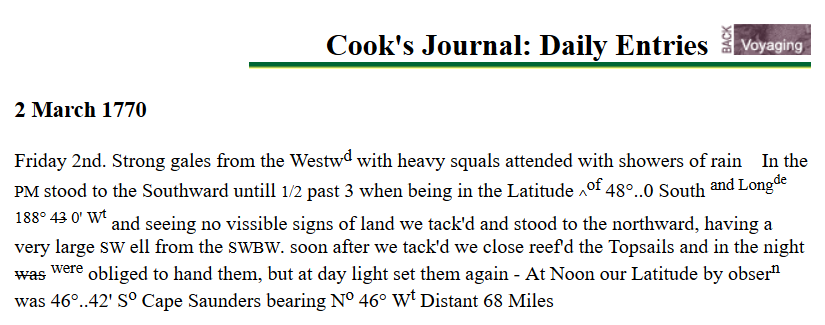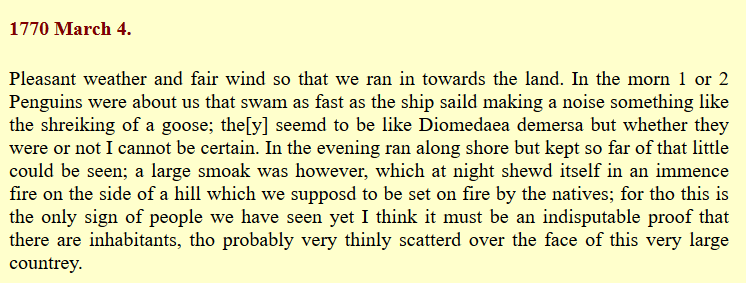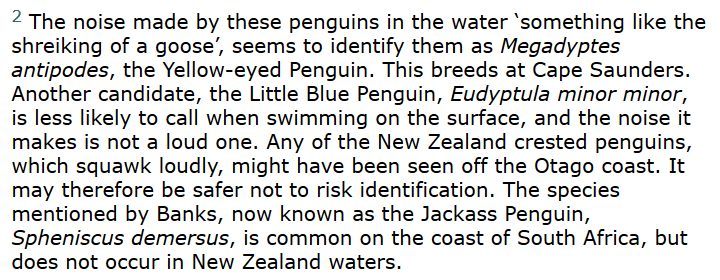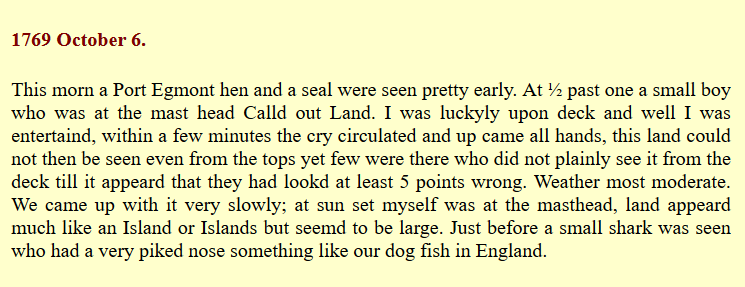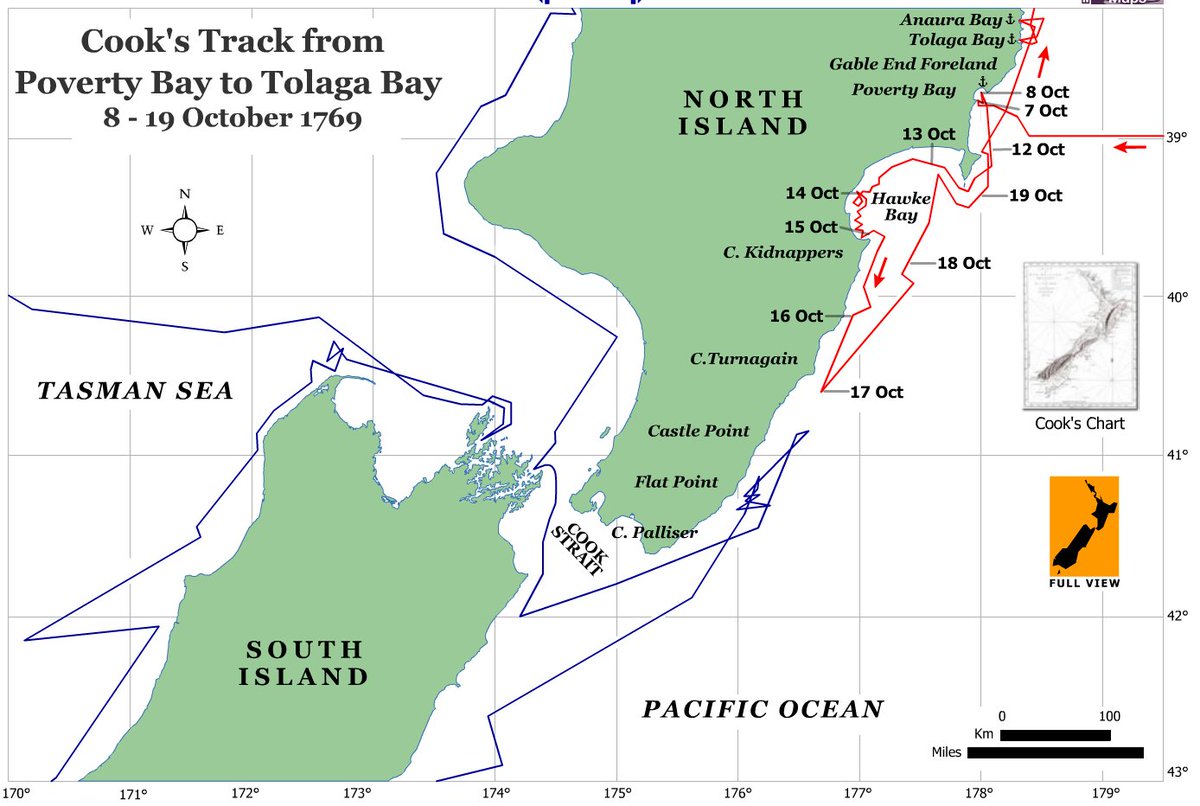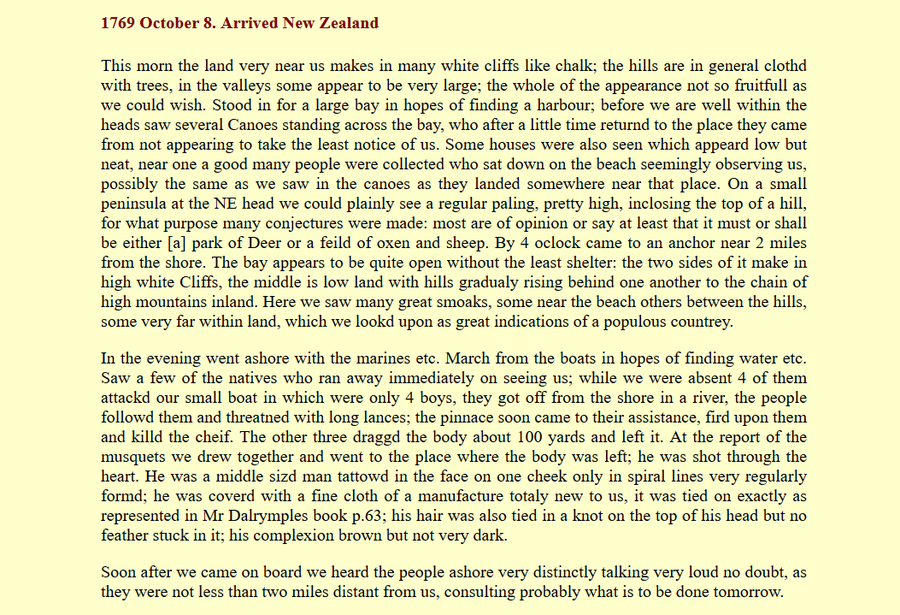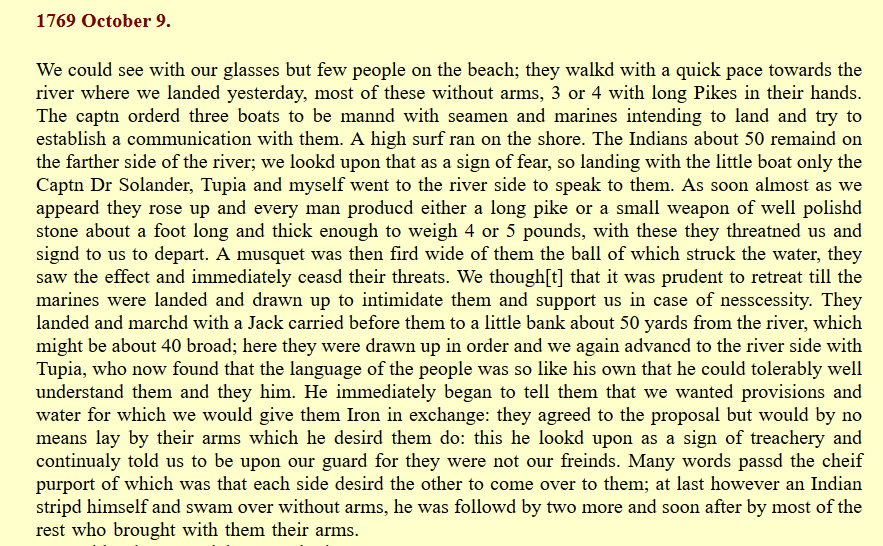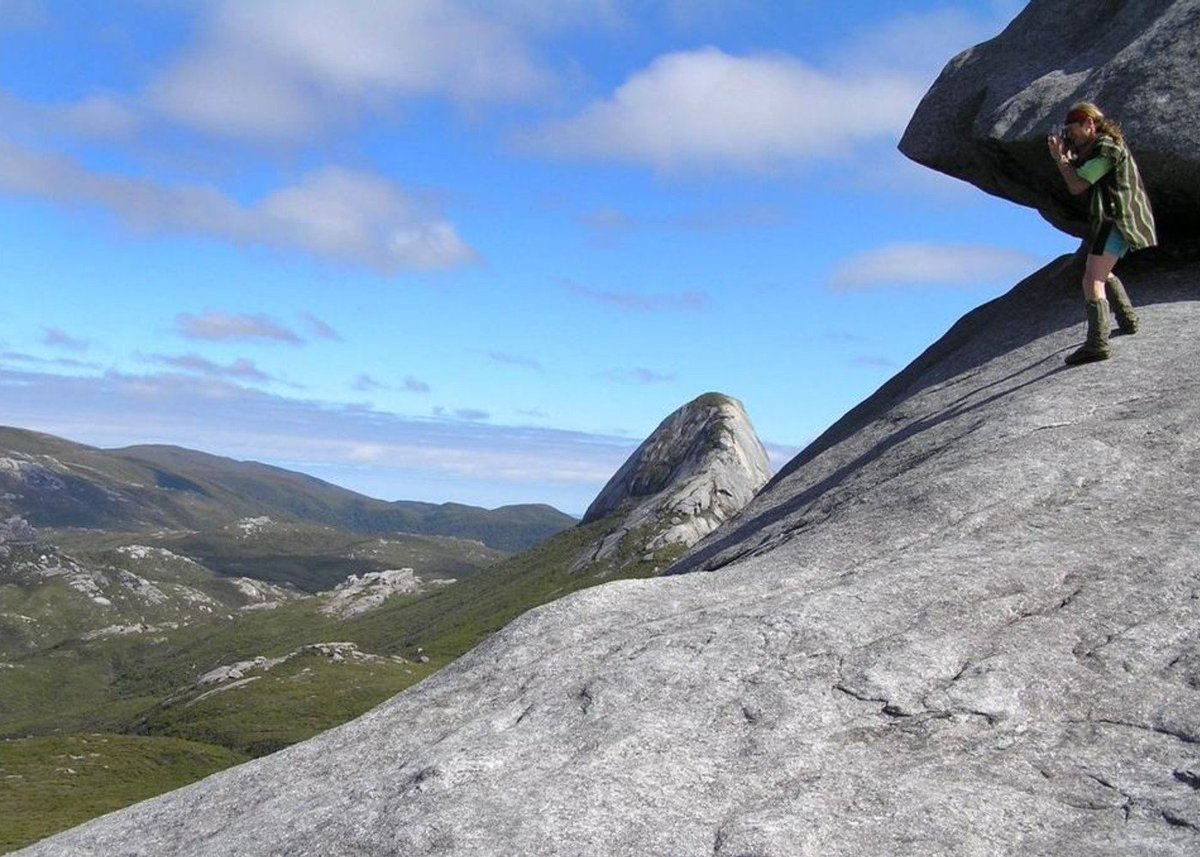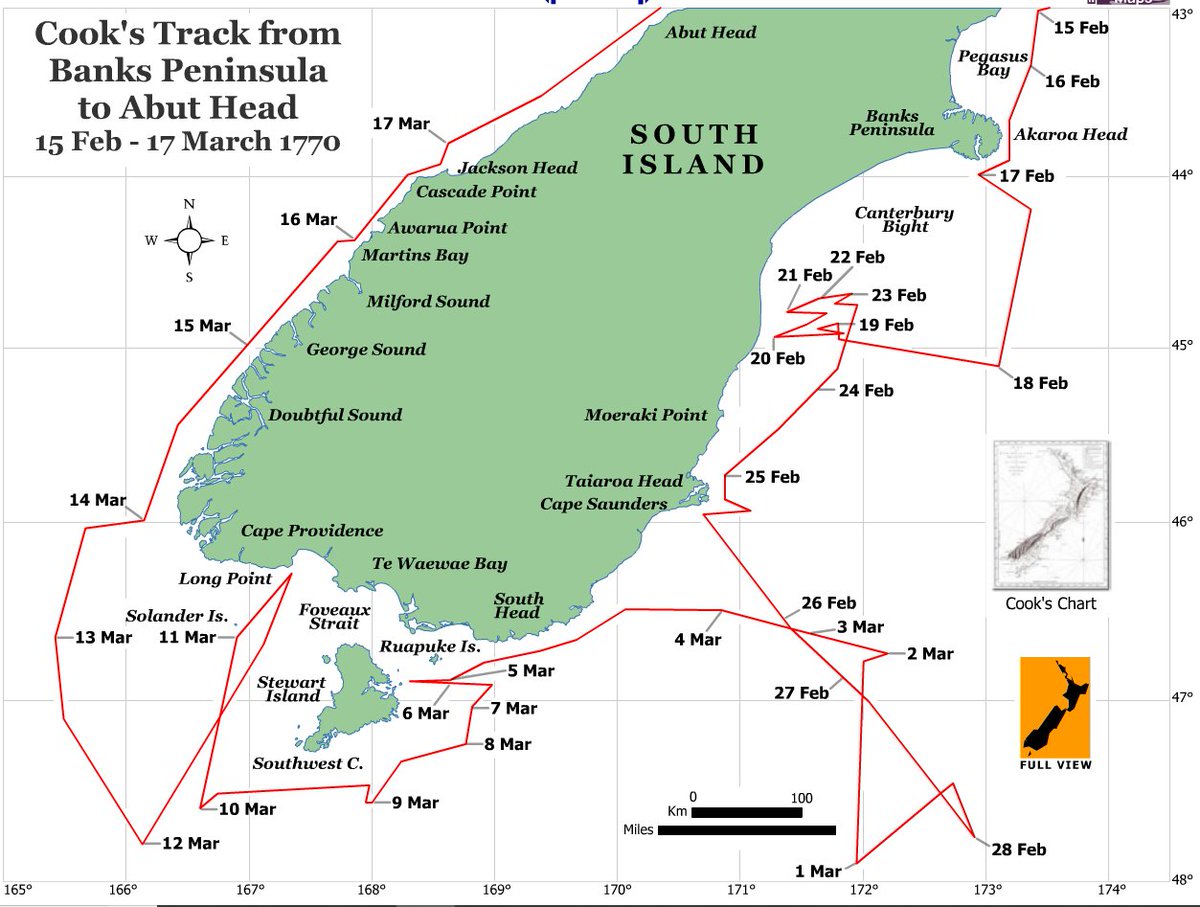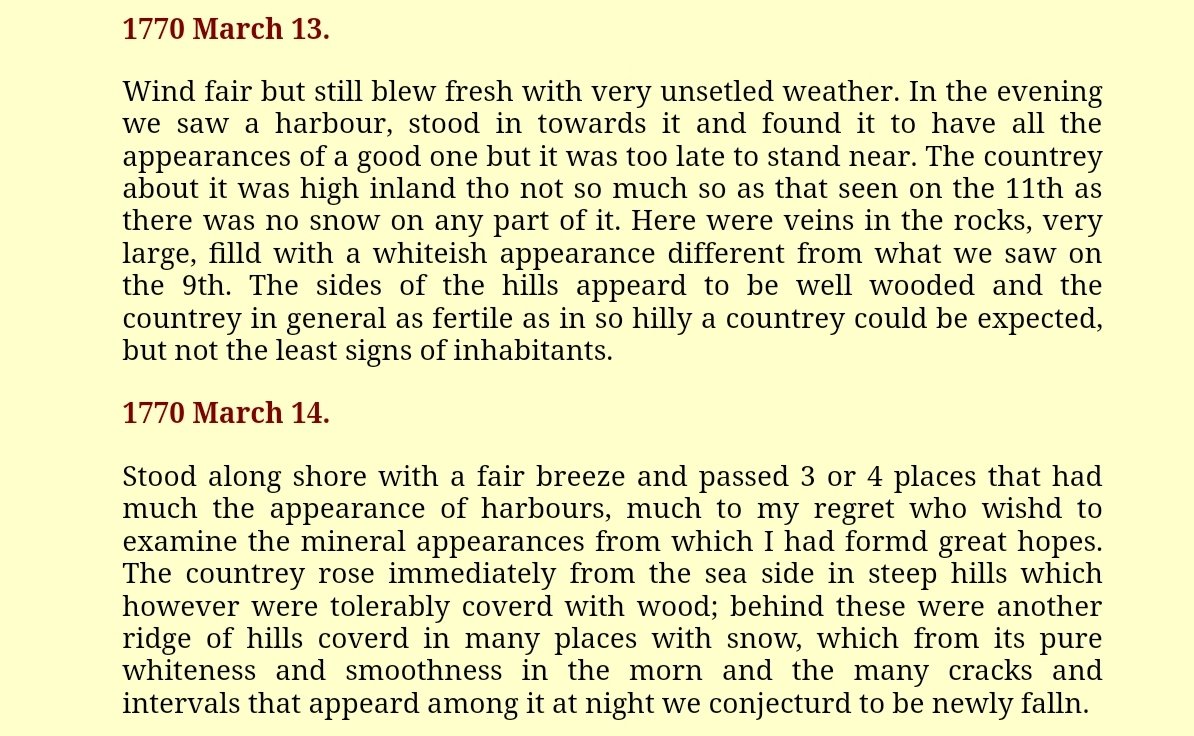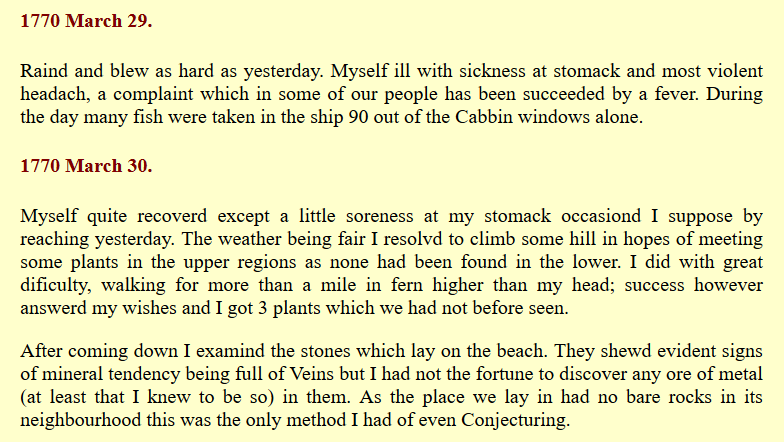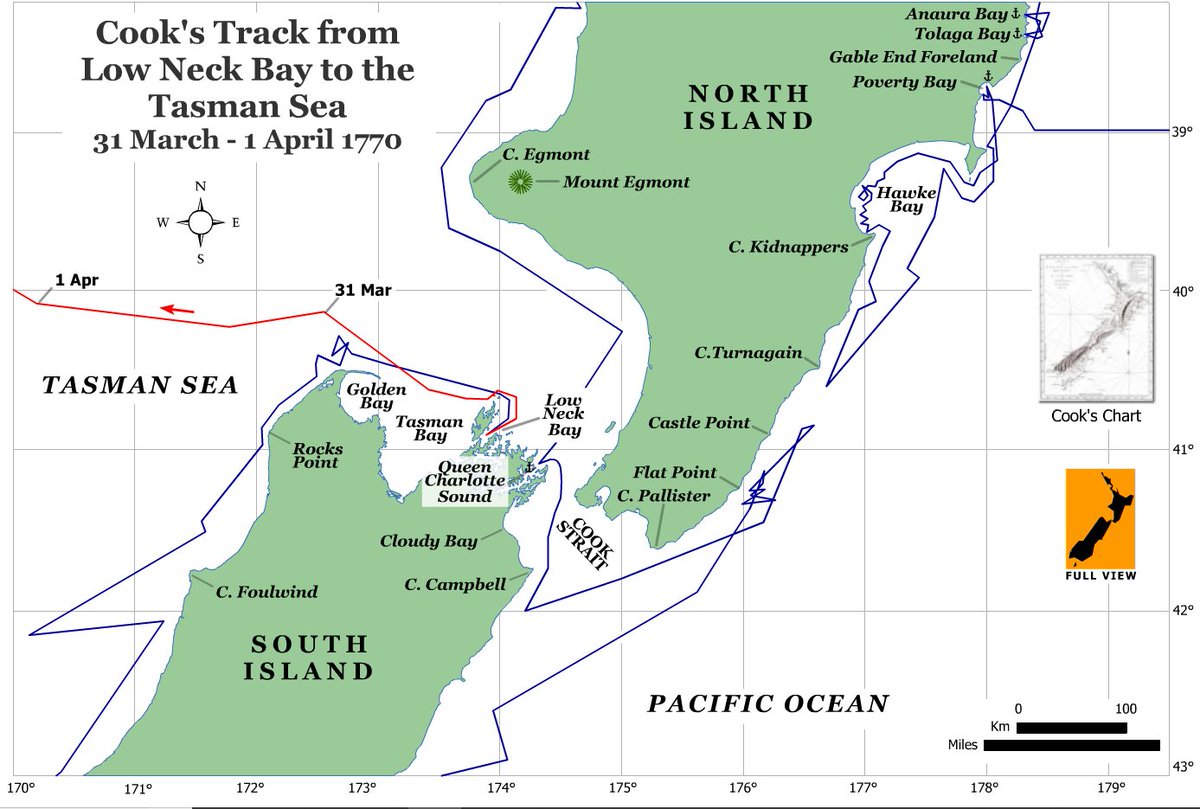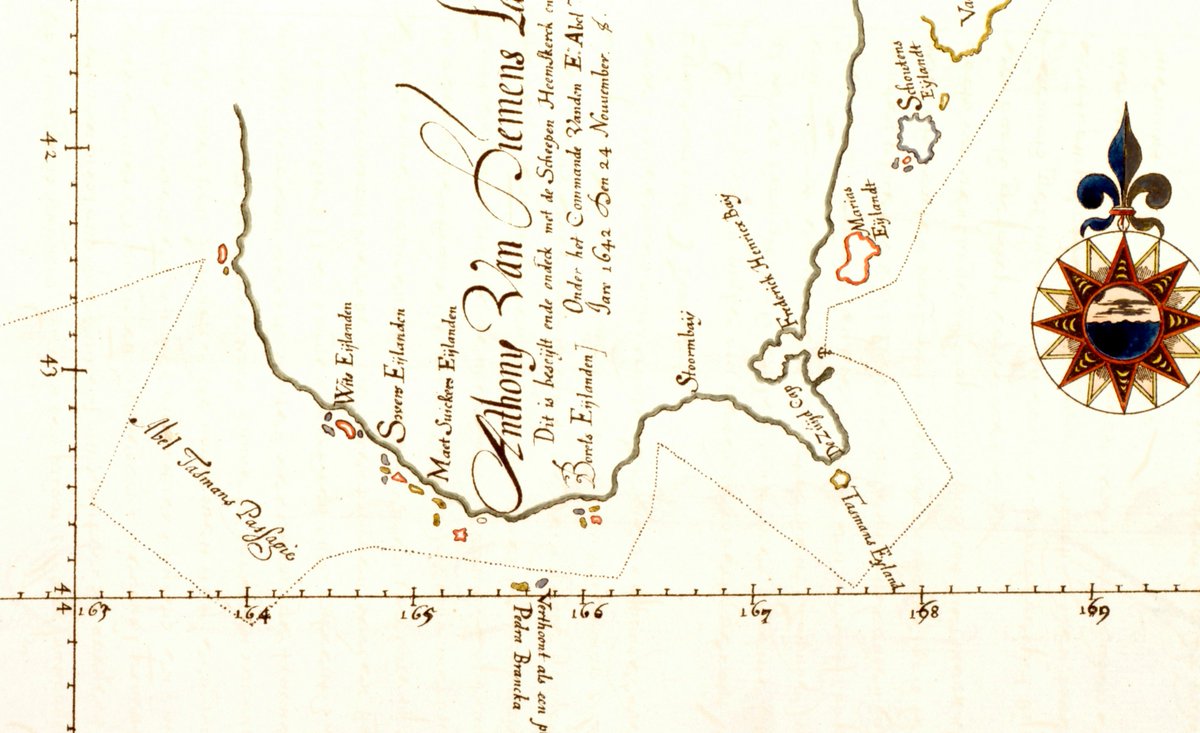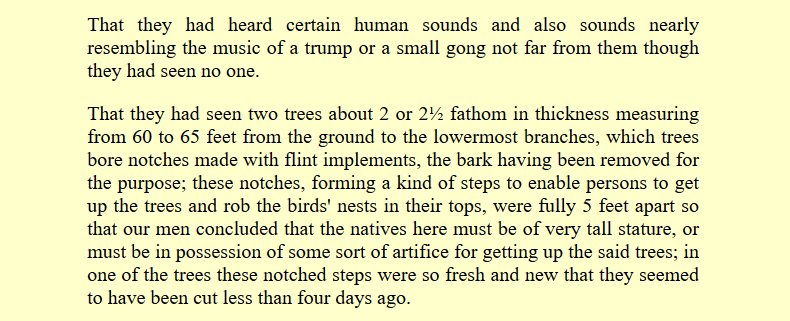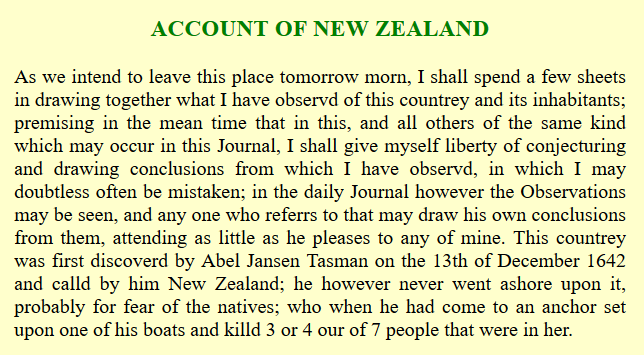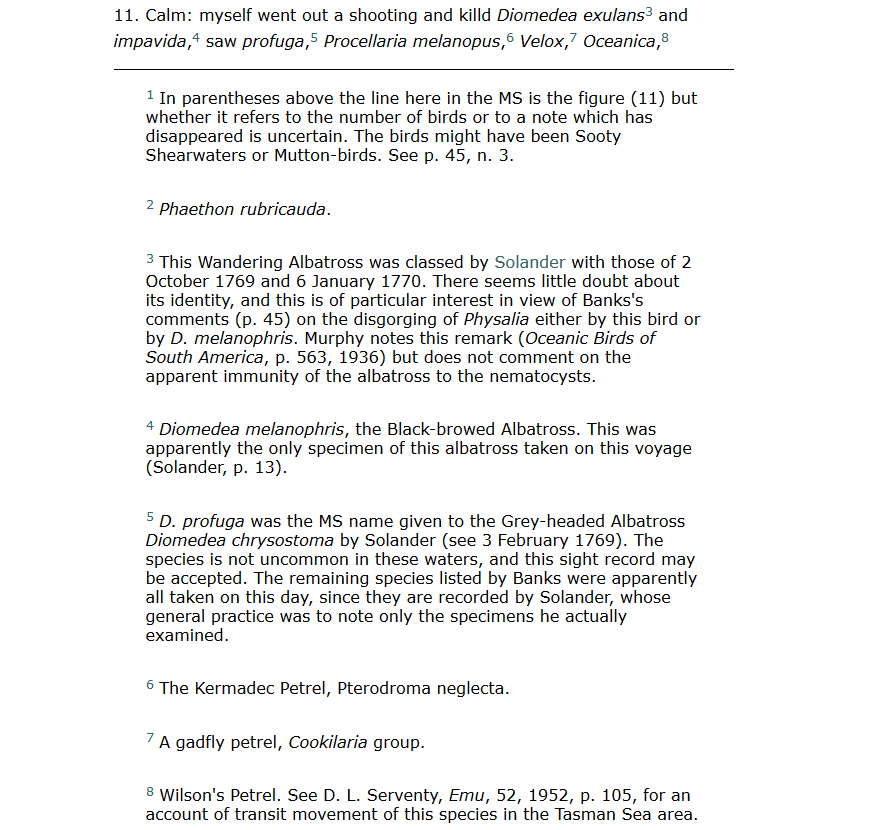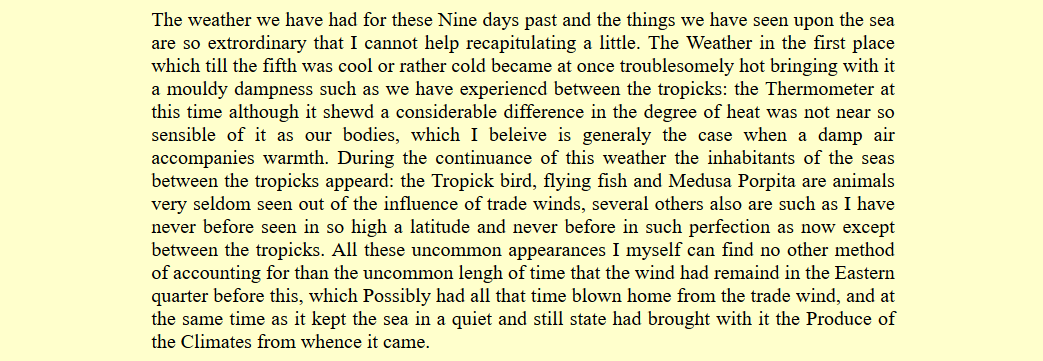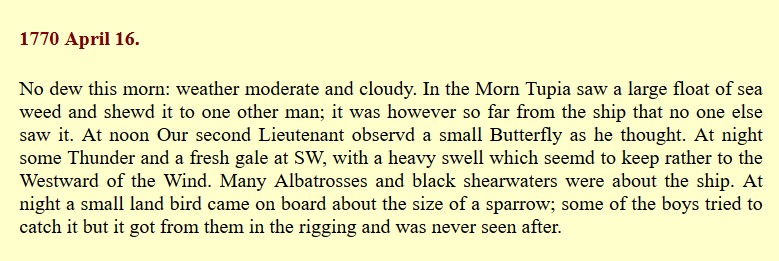#Banks250 Let& #39;s do this. Banks& #39; journal is much more fun than Cook& #39;s. Two hundred and fifty years ago today the 26 year old is seasick, having just left the sexual gratification of Tahiti.
Except was Banks gay? Maybe. Tupia is the Tahitian they& #39;ve befriended and taken on board.
Except was Banks gay? Maybe. Tupia is the Tahitian they& #39;ve befriended and taken on board.
Can read along here: #aug1769">http://gutenberg.net.au/ebooks05/0501141h.html #aug1769
(Never">https://gutenberg.net.au/ebooks05/... been able to relocate the book I read many years ago -- a ⁇contemporary popular account that juxtaposed grabs from Cook and Banks. The contrast is stark, sometimes fascinating.)
(Never">https://gutenberg.net.au/ebooks05/... been able to relocate the book I read many years ago -- a ⁇contemporary popular account that juxtaposed grabs from Cook and Banks. The contrast is stark, sometimes fascinating.)
BTW, ICYWW, the Gregorian calendar adjustment happened in 1752, so we are correct; this is 250 years ago to the day.
("...Wednesday, 2 September 1752 was followed by Thursday, 14 September 1752.")
("...Wednesday, 2 September 1752 was followed by Thursday, 14 September 1752.")
#Banks250: Today we are at Tupia& #39;s island, the modern Rurutu in the Austral group, south of Tahiti.
Cook& #39;s track to NZud is going to be tortuous:
http://southseas.nla.gov.au/journals/maps/17691007.html">https://southseas.nla.gov.au/journals/...
Cook& #39;s track to NZud is going to be tortuous:
http://southseas.nla.gov.au/journals/maps/17691007.html">https://southseas.nla.gov.au/journals/...
Yesterday, Tupia caught a tuna with a fish hook made from pearl shell. Don& #39;t try this one at home.
Today, we& #39;re exploring the island, to the dismay of the locals (despite Tupia& #39;s presence). Lt Gore (Banks& #39;s & #39;officer& #39;) finds need to shoot one, as you do...
Today, we& #39;re exploring the island, to the dismay of the locals (despite Tupia& #39;s presence). Lt Gore (Banks& #39;s & #39;officer& #39;) finds need to shoot one, as you do...
We seem to be off the west coast, from Cook& #39;s journal.
http://southseas.nla.gov.au/journals/cook/17690814.html
Remember">https://southseas.nla.gov.au/journals/... Cook is journaling for the 24 hours to noon; Banks is writing up his day in the evening, hence the date difference.
http://southseas.nla.gov.au/journals/cook/17690814.html
Remember">https://southseas.nla.gov.au/journals/... Cook is journaling for the 24 hours to noon; Banks is writing up his day in the evening, hence the date difference.
About here:
https://www.google.com/maps/@-22.4852216,-151.3466422,13881m/data=!3m1!1e3">https://www.google.com/maps/@-22...
https://www.google.com/maps/@-22.4852216,-151.3466422,13881m/data=!3m1!1e3">https://www.google.com/maps/@-22...
Apologies for the stuff up, but we get there in the end.
Seems the contemporary account I read was probably Hawkesworth: http://southseas.nla.gov.au/journals/hv23/278.html
Best">https://southseas.nla.gov.au/journals/... modern (heavily edited) edition may be this: https://www.amazon.com/Voyages-Captain-James-Cook-Illustrated/dp/0760350299">https://www.amazon.com/Voyages-C...
Seems the contemporary account I read was probably Hawkesworth: http://southseas.nla.gov.au/journals/hv23/278.html
Best">https://southseas.nla.gov.au/journals/... modern (heavily edited) edition may be this: https://www.amazon.com/Voyages-Captain-James-Cook-Illustrated/dp/0760350299">https://www.amazon.com/Voyages-C...
Worth noticing that Cook sailed ~straight for Tupia& #39;s island, a small thing in a large ocean, yet it seems to have been unknown to Europeans. How did he find it? Presumably Tupia found it - by observing the stars, as traditional Polynesians had for a couple of thousand of years.
Except that Banks understands him to say, on the 12th, "we are already past it" - probably a language glitch.
But how does he find it? Latitude is & #39;easy& #39;. Just remember which ring of obscure small stars dip to touch the southern horizon, through the night, when you are there.
But how does he find it? Latitude is & #39;easy& #39;. Just remember which ring of obscure small stars dip to touch the southern horizon, through the night, when you are there.
But we approach from the north, and the lookout spots it ahead ... don& #39;t need latitude. Cook deviates slightly east, so he knows the longitude is wrong. How?
Can get relative longitude from the stars, if remember what pattern was just rising in the east, earliest after sunset.
Can get relative longitude from the stars, if remember what pattern was just rising in the east, earliest after sunset.
No, can& #39;t (needs absolute time). I do not understand how the did it, but they did.
This says they used the obvious -- aim off, then longitude search. Maybe.
#Navigation_by_the_stars">https://en.wikipedia.org/wiki/Polynesian_navigation #Navigation_by_the_stars">https://en.wikipedia.org/wiki/Poly...
This says they used the obvious -- aim off, then longitude search. Maybe.
#Navigation_by_the_stars">https://en.wikipedia.org/wiki/Polynesian_navigation #Navigation_by_the_stars">https://en.wikipedia.org/wiki/Poly...
Banks has now written us a little treatise (after the 14th):
#manners">http://gutenberg.net.au/ebooks05/0501141h.html #manners">https://gutenberg.net.au/ebooks05/...
#manners">http://gutenberg.net.au/ebooks05/0501141h.html #manners">https://gutenberg.net.au/ebooks05/...
& #39;Pintado& #39; is a cape petrel. Own pic, off Stewart Is, NZud...
What are the albatrosses? "Common and Southern Albatross" == black-browed + wandering/southern royal?
But shy/mollymawk?
What are the albatrosses? "Common and Southern Albatross" == black-browed + wandering/southern royal?
But shy/mollymawk?
We& #39;re still tracking south btw, searching for the & #39;continent& #39;, as Cook has been instructed to do -- that& #39;s east of NZud (which we know from Tasman, 1642), and south of Tahiti, Tonga, Fiji (also know, from Tasman and others).
Cook, on the 15th...
http://southseas.nla.gov.au/journals/cook/17690815.html">https://southseas.nla.gov.au/journals/...
http://southseas.nla.gov.au/journals/cook/17690815.html">https://southseas.nla.gov.au/journals/...
Banks& #39;s birds again: "...a shearwater in size and shape like the common, but grey or whitish on the head and back". What is that? Huttons shearwater? More black than grey. Dunno.
I see Beaglehole thinks this is a white-headed petrel, *Pterodroma lessonii*. Could be.
http://nzetc.victoria.ac.nz/tm/scholarly/tei-Bea01Bank-t1-body-d7-d1.html
WP:">https://nzetc.victoria.ac.nz/tm/schola...
http://nzetc.victoria.ac.nz/tm/scholarly/tei-Bea01Bank-t1-body-d7-d1.html
WP:">https://nzetc.victoria.ac.nz/tm/schola...
Poor Rayden (28th).
"At 10 am departed this life Jno Radon Boatswains Mate, his death was occasioned by the Boatswain, out of mere good nature, giving him part of a Bottle of rum last night, which it is supposed he drank all at once...", Cook.
"At 10 am departed this life Jno Radon Boatswains Mate, his death was occasioned by the Boatswain, out of mere good nature, giving him part of a Bottle of rum last night, which it is supposed he drank all at once...", Cook.
We& #39;ve seen a comet!
It& #39;s the great long-period comet C/1769 P1, first reported by famous astronomer Charles Messier in Paris, 8 August 1769 (of course Cook didn& #39;t know that).
C/1769 P1 has an orbital period of about 2090 years, so shan& #39;t been seen again for a while
https://en.wikipedia.org/wiki/C/1769_P1 ">https://en.wikipedia.org/wiki/C/17...
C/1769 P1 has an orbital period of about 2090 years, so shan& #39;t been seen again for a while
https://en.wikipedia.org/wiki/C/1769_P1 ">https://en.wikipedia.org/wiki/C/17...
ICYWW, on 26 January 1770 James Cook is anchored in Queen Charlotte Sound at the northern end of the South Island, New Zealand, being generously fed by the locals. He climbs another hill, having days earlier & #39;discovered& #39; Cook Strait by climbing Kaitapeha peak on Arapawa Island.
Here. He won& #39;t be shooting Australians for another three months yet.
http://southseas.nla.gov.au/journals/maps/17700206.html">https://southseas.nla.gov.au/journals/...
http://southseas.nla.gov.au/journals/maps/17700206.html">https://southseas.nla.gov.au/journals/...
There& #39;s quite a nice chart. He& #39;ll sail through there in about 10 days, which is a bit scary in a little tub of a thing a long way from home.
He has already circumnavigated the North Island, nearly, and will shortly be sailing up the east coast to complete that task. That& #39;s after running the tidal race through the Strait, which is no small thing in a clunky coal transport (as we& #39;ll see much later, in Torres Strait).
Here& #39;s #Banks250 at Queen Charlotte Sound. Has a talent for it, doesn& #39;t he. Gore doesn& #39;t shoot anyone.
Cook & #39;discovers& #39;, ahem, & #39;Cook Strait& #39; (Te Moana-o-Raukawa), and Banks discovers fishing. Is one of the things that immediately strikes, in early accounts -- how many damn fish there are. What is the industrial depletion factor? The oft-cited 90% seems way too low.
Is Banks gay? Still don& #39;t know, but he can be pretty funny. February 3:
#Banks250: Today we& #39;re finally underway, through "Cook& #39;s" strait, but not without issues. The little tub cannot sail upwind you see, so confined navigation is fraught, and when you add strong tidal currents, dangerous. Your bower is your friend.
Banks is inclined to dramatise.
Banks is inclined to dramatise.
They used this bower anchor. (Perhaps the actual one -- both large anchors were left behind at Endeavour Reef after being used to haul grounded Endeavour off. This one was later recovered, restored, and emplaced in a Museum in Cooktown.)
#Banks250: Today we completed circumnavigation of the North Island by sailing up the east coast to almost where we reached four months earlier, on 17 October. (Unlike at Australia, Cook did circumnavigate New Zealand.)
We spot Mt "Cook", likely with rather more snow and ice than exists today.
#feb1770">http://gutenberg.net.au/ebooks05/0501141h.html #feb1770">https://gutenberg.net.au/ebooks05/...
#feb1770">http://gutenberg.net.au/ebooks05/0501141h.html #feb1770">https://gutenberg.net.au/ebooks05/...
#Banks250: Banks is 27 today*, but doesn& #39;t mention it. Seems not to have been the thing, on board at least.
(*Sort of. He was born 13 Feb 1743, but back-dating the Gregorian Calendar change of Sept 1752 would actually make that 24 Feb. He doesn& #39;t mention it on either date.)
(*Sort of. He was born 13 Feb 1743, but back-dating the Gregorian Calendar change of Sept 1752 would actually make that 24 Feb. He doesn& #39;t mention it on either date.)
Death of Captain Cook day...
"It is true that we very proudly killed Cook, who brought VD and tuberculosis to the Hawaii. In fact, we Hawaiians still celebrate every 14 February as Hauʻoli Lā Hoʻomake iā Kapena Kuke, or happy Death of Captain Cook Day." https://www.sbs.com.au/nitv/article/2019/02/14/how-foolish-rumour-hawaiians-ate-cook-began">https://www.sbs.com.au/nitv/arti...
"It is true that we very proudly killed Cook, who brought VD and tuberculosis to the Hawaii. In fact, we Hawaiians still celebrate every 14 February as Hauʻoli Lā Hoʻomake iā Kapena Kuke, or happy Death of Captain Cook Day." https://www.sbs.com.au/nitv/article/2019/02/14/how-foolish-rumour-hawaiians-ate-cook-began">https://www.sbs.com.au/nitv/arti...
Sort of, if you correct for the Gregorian calendar change, as we& #39;ve said. https://twitter.com/JackDAshby/status/1231859765116112897?s=19">https://twitter.com/JackDAshb...
Again he doesn& #39;t mention it. We& #39;re off the south-east coast of the South Island, too far offshore to notice much about it. (Certainly didn& #39;t see the Moeraki Boulders.) We& #39;re about to get blown about by a cold SW& #39;er, bit of a feature of NZud summer weather. #Banks250
Cook now sails a long reach out away from the coast, perhaps the safest thing to do in a SW& #39;erly gale. Or maybe he& #39;s still checking for the mystical & #39;continent& #39;, after Gore reckoned he& #39;d seen land to the SE, few days back, off "Banks" Peninsular. Banks doesn& #39;t say why.
Remember that the & #39;continent& #39; they& #39;re searching for here is *not* Australia. Cook is a late European explorer to the region. The position and basic shape of Australia is already known.
This Dutch map is 1689, nearly a hundred years before Cook:
https://en.m.wikipedia.org/wiki/Gerard_van_Schagen">https://en.m.wikipedia.org/wiki/Gera...
This Dutch map is 1689, nearly a hundred years before Cook:
https://en.m.wikipedia.org/wiki/Gerard_van_Schagen">https://en.m.wikipedia.org/wiki/Gera...
Tasman sailed across the Tasman Sea from Tasmania to New Zealand in late 1642, then up to Tonga and New Britian (PNG). Cook knows this, as did the Admiralty who wrote his sealed orders. Is exactly zero possibility that the continent of Australia extends to where he is searching.
And if you add the others, the region was pretty well known ... except east of New Zealand, where Cook is. (The suspicion was that the west coast of NZud that Tasman had surveyed might actually be the west coast of a South Pacific continent. Wasn& #39;t.)
http://gutenberg.net.au/ebooks06/0600531h.html">https://gutenberg.net.au/ebooks06/...
http://gutenberg.net.au/ebooks06/0600531h.html">https://gutenberg.net.au/ebooks06/...
Amusing thing is that while Cook did not circumnavigate Australia (on his east coast voyage), Tasman actually did, back in 1642-43. He also mapped, accurately, as much or more of the Australian coast than Cook did, 125 years earlier, in 1644. We have the wrong hero.
And he presumably did that without the & #39;easy& #39; lunar distance longitude observation, which only entered the Admiralty Almanac a few years before Cook sailed (Cook had no chronometer in Australia; that was later). I don& #39;t know how Tasman did longitude, but would like to.
(So, definitely did not know that the early lunar distance calculations for the almanac were performed by the famous Swiss mathematician Leonhard Euler, using what is now known as the & #39;forward Euler& #39; explicit finite difference method. The things you...) https://www.theguardian.com/science/the-h-word/2013/apr/15/history-science">https://www.theguardian.com/science/t...
(The most complex computer calculations routinely performed today -- those in global weather and global climate models -- are finite difference integrations not hugely dissimilar to those of Euler.)
Eventually, we shall return to #Banks250. Promise.
Eventually, we shall return to #Banks250. Promise.
Today the southwester has eased a bit and Cook is beating back in towards the coast (sort of -- the Endeavour can& #39;t really beat, but it can reach ... uncomfortably).
Sorry, links:
#mar1770">http://gutenberg.net.au/ebooks05/0501141h.html #mar1770
https://gutenberg.net.au/ebooks05/... href=" http://southseas.nla.gov.au/journals/maps/17700317.html">https://southseas.nla.gov.au/journals/... (big map needs Flash ... urghh).
Here& #39;s Cook& #39;s chart. "Bank& #39;s Island" ... haha.
https://nla.gov.au/nla.obj-230689929/view">https://nla.gov.au/nla.obj-2...
#mar1770">http://gutenberg.net.au/ebooks05/0501141h.html #mar1770
Here& #39;s Cook& #39;s chart. "Bank& #39;s Island" ... haha.
https://nla.gov.au/nla.obj-230689929/view">https://nla.gov.au/nla.obj-2...
And here& #39;s Cook. He thinks it& #39;s a bit lumpy too, apologetically shortening sail.
http://southseas.nla.gov.au/journals/cook/17700302.html">https://southseas.nla.gov.au/journals/...
http://southseas.nla.gov.au/journals/cook/17700302.html">https://southseas.nla.gov.au/journals/...
Consensus is that these were probably yellow-eyed penguins, now a critically endangered species. #Banks250
Beaglehole again.
http://nzetc.victoria.ac.nz/tm/scholarly/tei-Bea01Bank-t1-body-d7-d8.html">https://nzetc.victoria.ac.nz/tm/schola...
http://nzetc.victoria.ac.nz/tm/scholarly/tei-Bea01Bank-t1-body-d7-d8.html">https://nzetc.victoria.ac.nz/tm/schola...
We managed to skip this one. Best go back and correct. Prediction: Gore. https://dw.com/en/britain-expresses-regret-over-killing-of-maori-when-captain-cook-first-landed/a-50683199">https://dw.com/en/britai...
Was distracted back when the exciting first sighting of NZud came around back in October. #Banks250
#oct1769">http://gutenberg.net.au/ebooks05/0501141h.html #oct1769">https://gutenberg.net.au/ebooks05/...
#oct1769">http://gutenberg.net.au/ebooks05/0501141h.html #oct1769">https://gutenberg.net.au/ebooks05/...
We& #39;re coming in to Gisborne...
So it perhaps wasn& #39;t Gore who ordered the shooting, since surely he was with the shore party...
...The first shooting, but there& #39;s no doubt who does the shooting the next day. Interestingly, Tupia can talk with them. Māori people first arrived in New Zealand around 1350, about 400 years before Cook and Banks ... probably from the Society Islands, Tupia& #39;s home.
It& #39;s Banks himself who starts the shooting.
Later in the day, it is piracy, murder and kidnapping. Those who imagine these Englishmen as some sort of gentle folk are badly mistaken.
"Thus ended the most disagreeable day my life has yet seen; black be the mark for it and heaven send that such may never return to embitter future reflection", Banks.
Best we return to realtime #Banks250.
Best we return to realtime #Banks250.
Back at 9 March, we& #39;re close to some submerged rocks off Stewart Island, which rather spooks Banks. The geologising appears to be about the granite cliffs of Port Pegasus at the southern end of the island.
#Banks250 is about to be pissed off that Cook won& #39;t sail into any of the fjords. Seems they have a little tiff about it. Cook later explained that while he could easily sail in ahead of the prevailing westerly, he might have to wait a month for an easterly to get out again.
We& #39;re now back at anchor in Marlborough Sounds, preparing to set sail for Australia. #Banks250 is about to come down with the virus. Did they bring it with them, our catch it from Māori? Former, methinks.
And, notice, those damn fish again. Ninety, caught out the window.
And, notice, those damn fish again. Ninety, caught out the window.
#Banks250. https://twitter.com/RichardMcLellan/status/1243787207053201408?s=20">https://twitter.com/RichardMc...
And today we& #39;re sailing for Australia! (This is no joke.)
http://southseas.nla.gov.au/journals/maps/17700401.html">https://southseas.nla.gov.au/journals/...
http://southseas.nla.gov.au/journals/maps/17700401.html">https://southseas.nla.gov.au/journals/...
...Which if that were the intention (below), they missed by quite a lot. It& #39;s about 600 km from Freycinet Peninsular to Point Hicks. (But recall the prevailing wind, and that Endeavour cannot do much better than reach -- sail at ~90° to it.)
Tasman& #39;s map of Tasmania is, shall we say, basic. But his names persist: "Tasman& #39;s Island", "Maria& #39;s Island", "Schouten& #39;s Island".
https://lib-dbserver.princeton.edu/visual_materials/maps/websites/pacific/tasman/map-tasmania.jpg">https://lib-dbserver.princeton.edu/visual_ma...
https://lib-dbserver.princeton.edu/visual_materials/maps/websites/pacific/tasman/map-tasmania.jpg">https://lib-dbserver.princeton.edu/visual_ma...
Tasman anchored in the southern part of Marion Bay in early December 1642 ... where we get the famous observation of Tasmanian tree climbing. (...Which is much-disputed. Don& #39;t know why; seems clear. These were not idiots.)
#0600571h-16">http://gutenberg.net.au/ebooks06/0600571h.html #0600571h-16">https://gutenberg.net.au/ebooks06/...
#0600571h-16">http://gutenberg.net.au/ebooks06/0600571h.html #0600571h-16">https://gutenberg.net.au/ebooks06/...
...And this fascinating observation of the vegetation, the thrust of which will be repeated in European explorers& #39; accounts for centuries. (Yet it, too, is routinely disputed. Why? Ever been to the northern Tasman Peninsular; tried to walk through the forest there now?)
But back to #Banks250. He has written us another treatise.
#nz">http://gutenberg.net.au/ebooks05/0501141h.html #nz">https://gutenberg.net.au/ebooks05/...
#nz">http://gutenberg.net.au/ebooks05/0501141h.html #nz">https://gutenberg.net.au/ebooks05/...
#Banks250: Nice piece on Tupia. https://www.abc.net.au/radionational/programs/the-history-listen/navigating-1770/12017644">https://www.abc.net.au/radionati...
It& #39;s a pretty quiet Tasman crossing. Banks will shortly be doing some & #39;modern& #39; birdwatching -- shoot & #39;em and work & #39;em out later (except with a gun instead of a long lens). We finally sort out the albatrosses.
Beaglehole:
http://nzetc.victoria.ac.nz/tm/scholarly/tei-Bea02Bank-t1-body-d3-d1.html">https://nzetc.victoria.ac.nz/tm/schola...
Beaglehole:
http://nzetc.victoria.ac.nz/tm/scholarly/tei-Bea02Bank-t1-body-d3-d1.html">https://nzetc.victoria.ac.nz/tm/schola...
So it& #39;s ~"too-pie-yah" (equal emphasis), not "to-pee-ah" as Banks anglicises it. But I& #39;m sticking with Banks& #39;s spelling; this is his story. https://www.youtube.com/watch?v=7A1KhRYpuMI">https://www.youtube.com/watch...
13 April: We& #39;re in a bit of a tropical weather outburst, seems, maybe also an East Australian Current (warm) eddy, but the creatures he describes and not super rare at the latitude.
(Beaglehole has the modern IDs if interested. Seems to have been a bit of a bird expert.)
(Beaglehole has the modern IDs if interested. Seems to have been a bit of a bird expert.)

 Read on Twitter
Read on Twitter
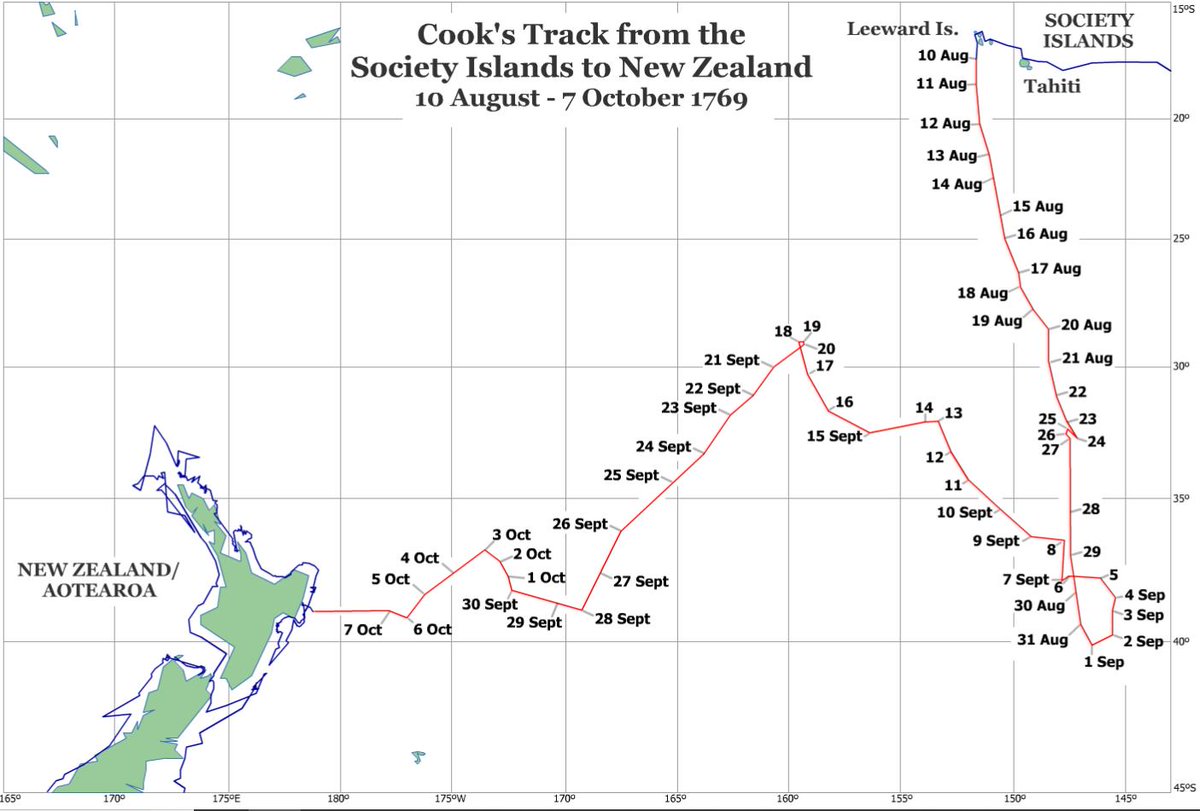
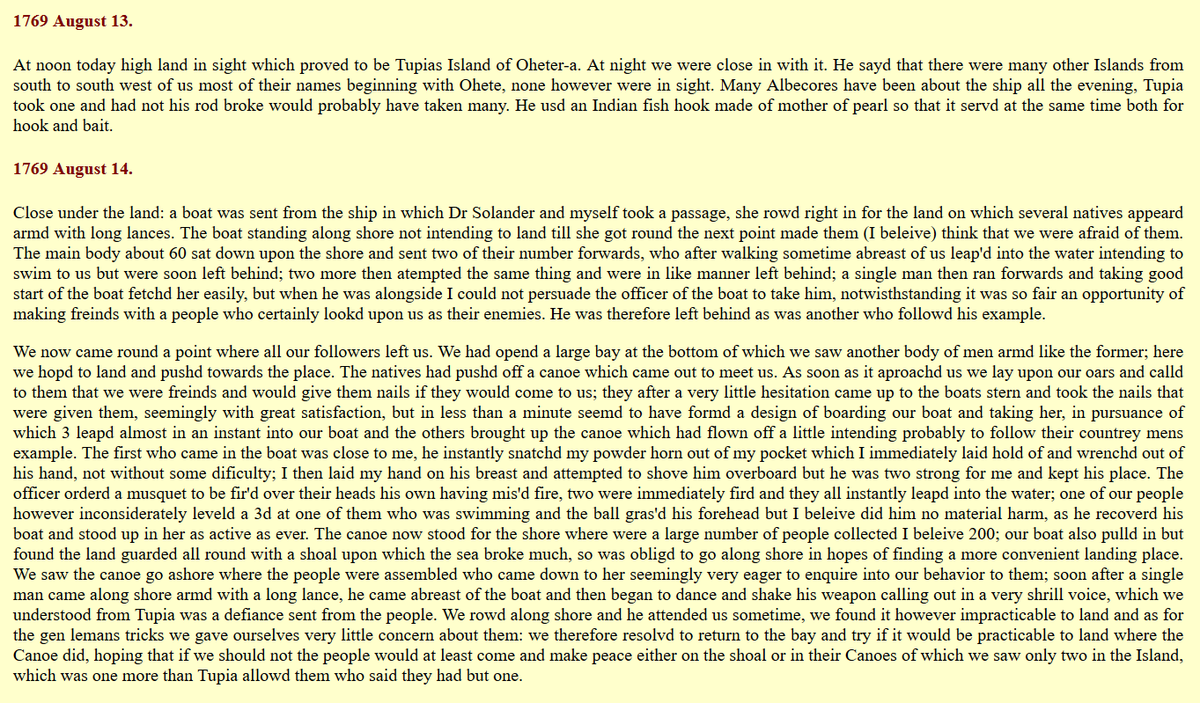
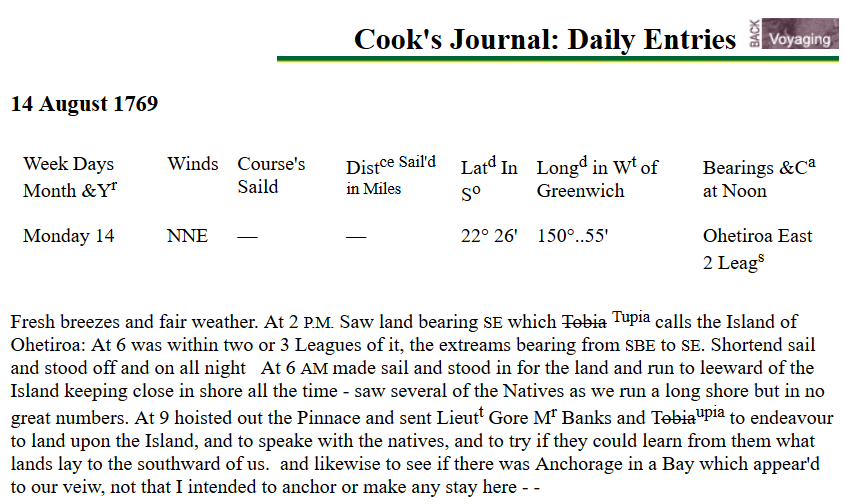
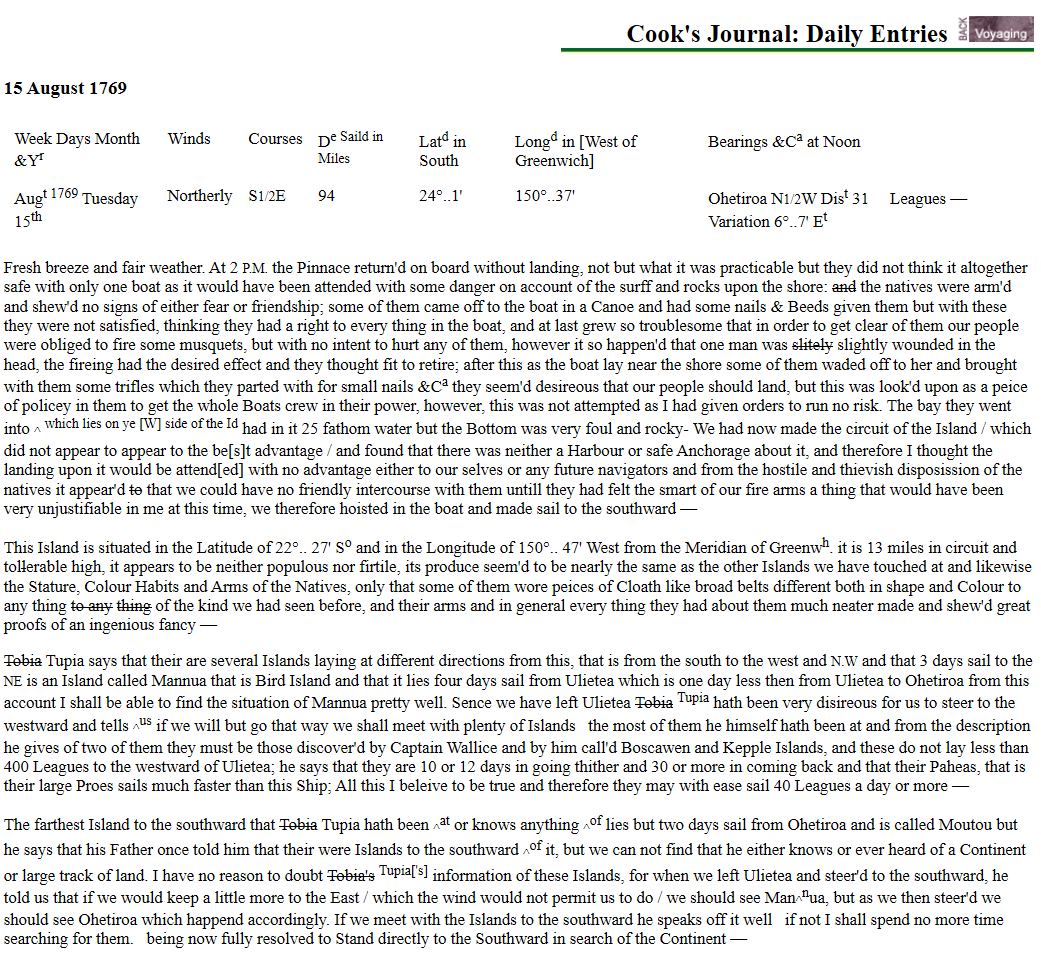
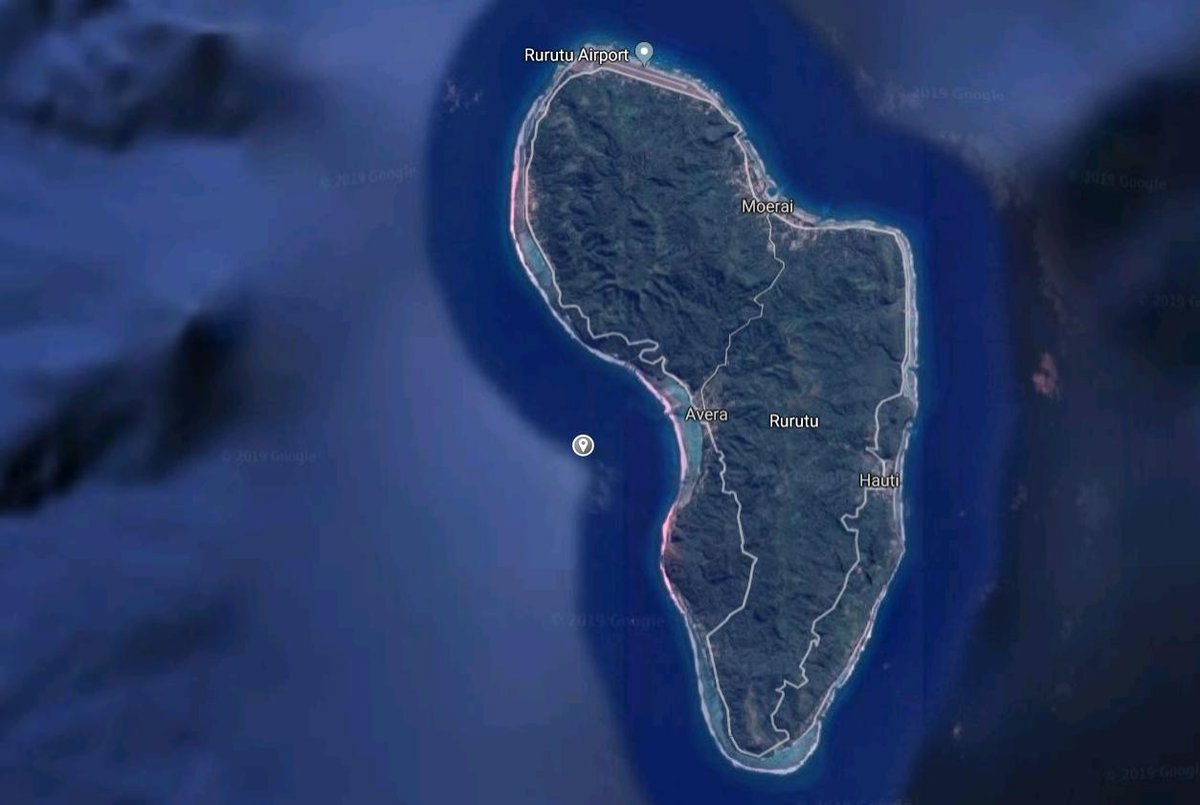
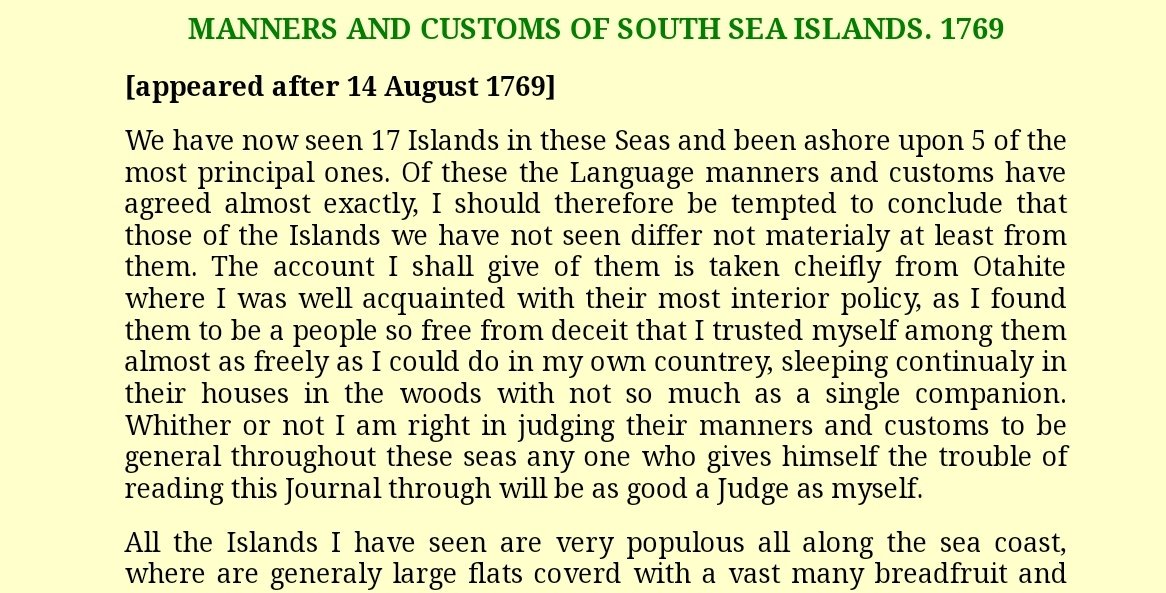
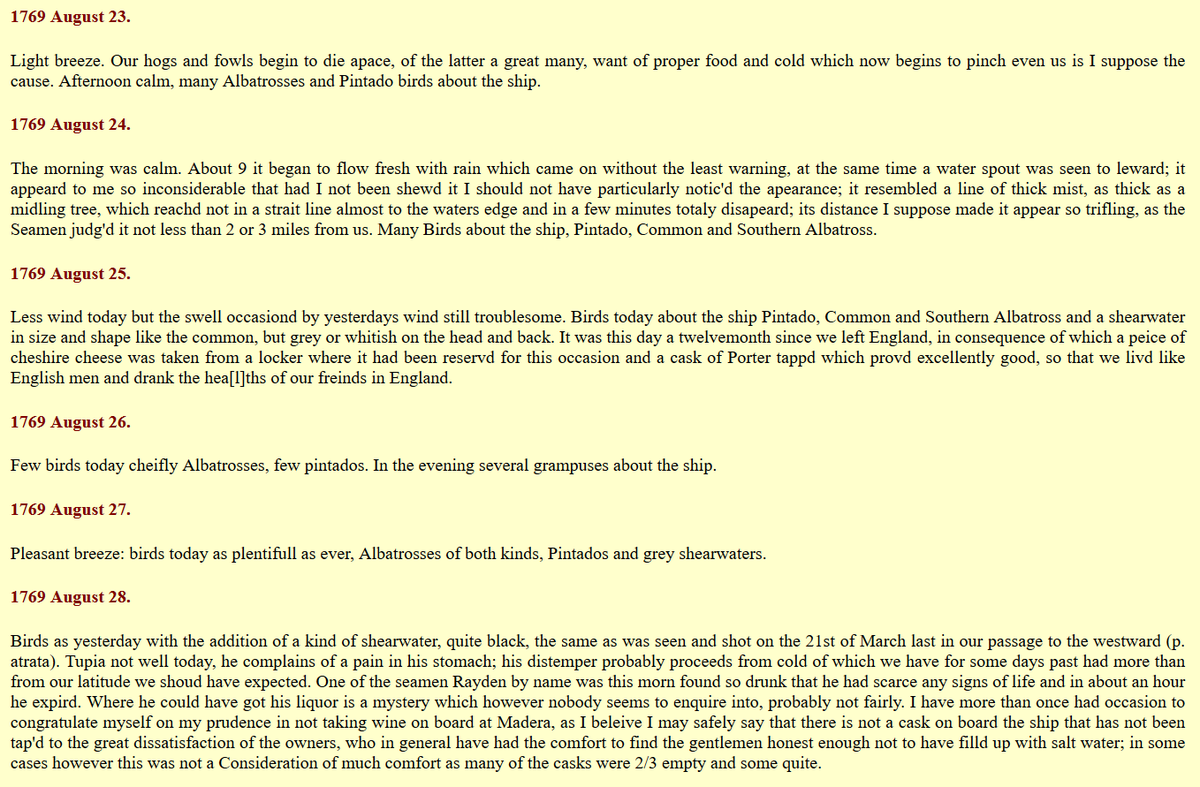
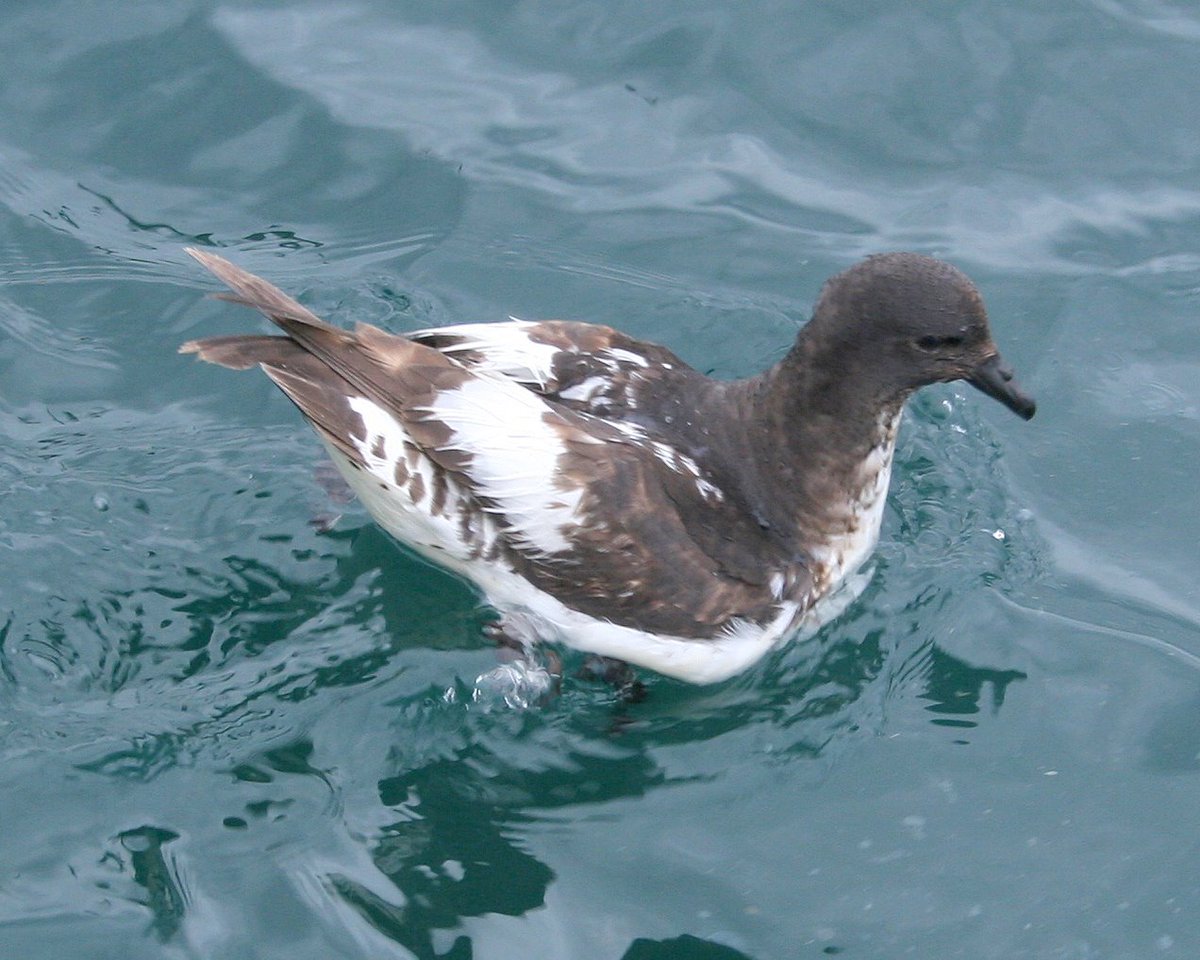
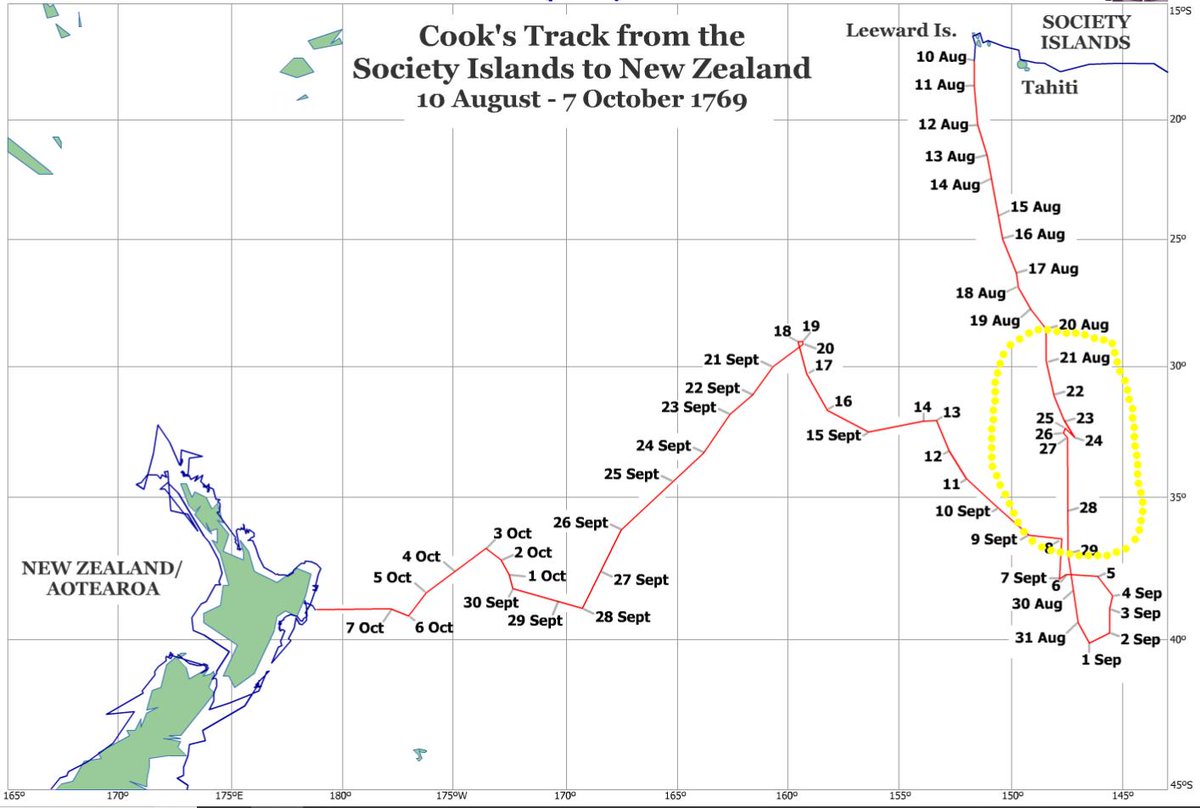

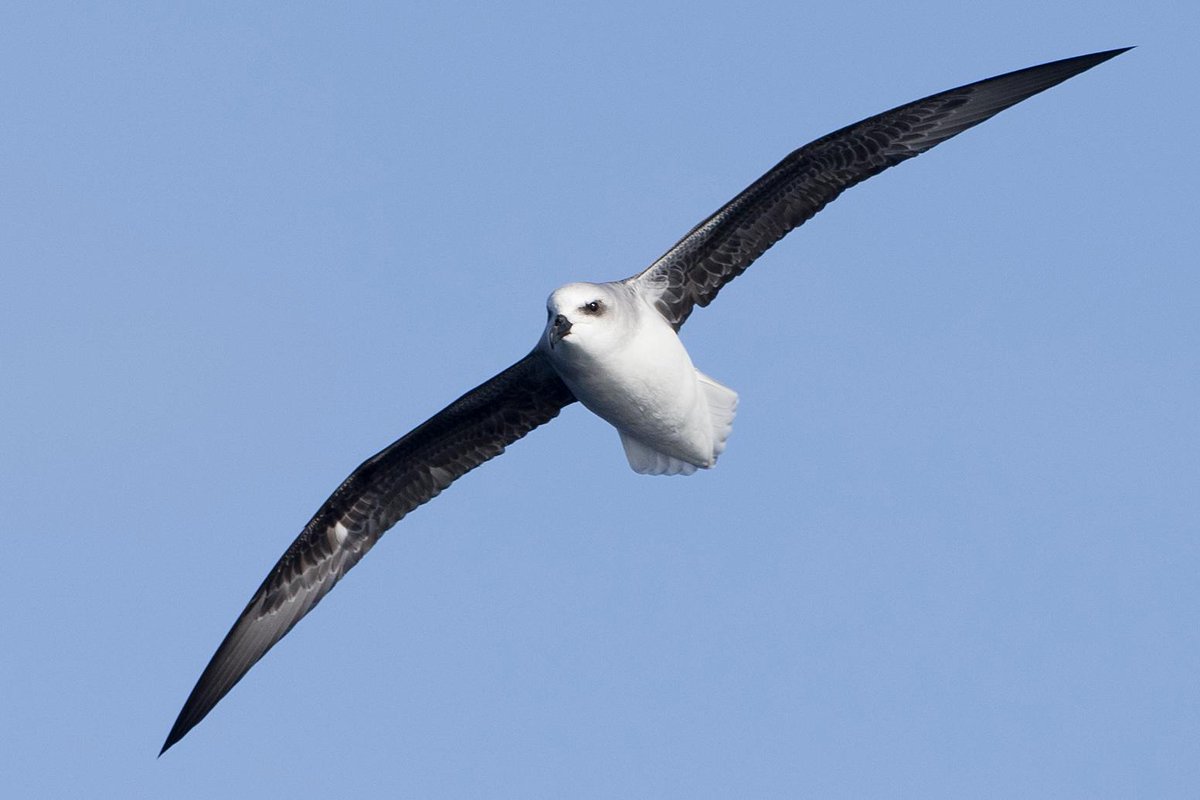
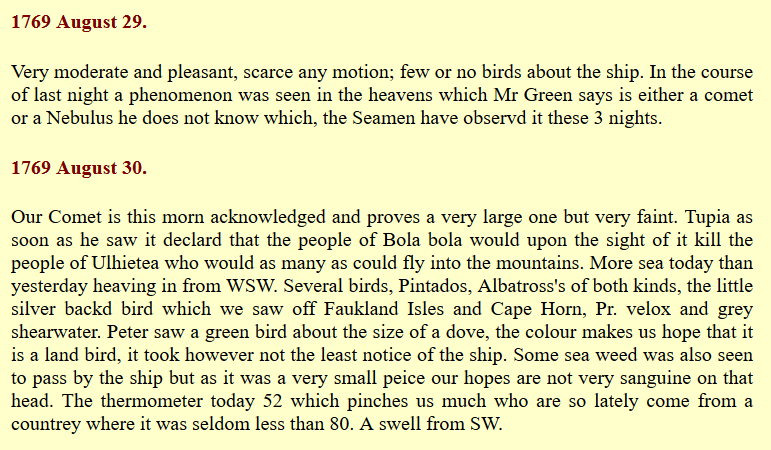

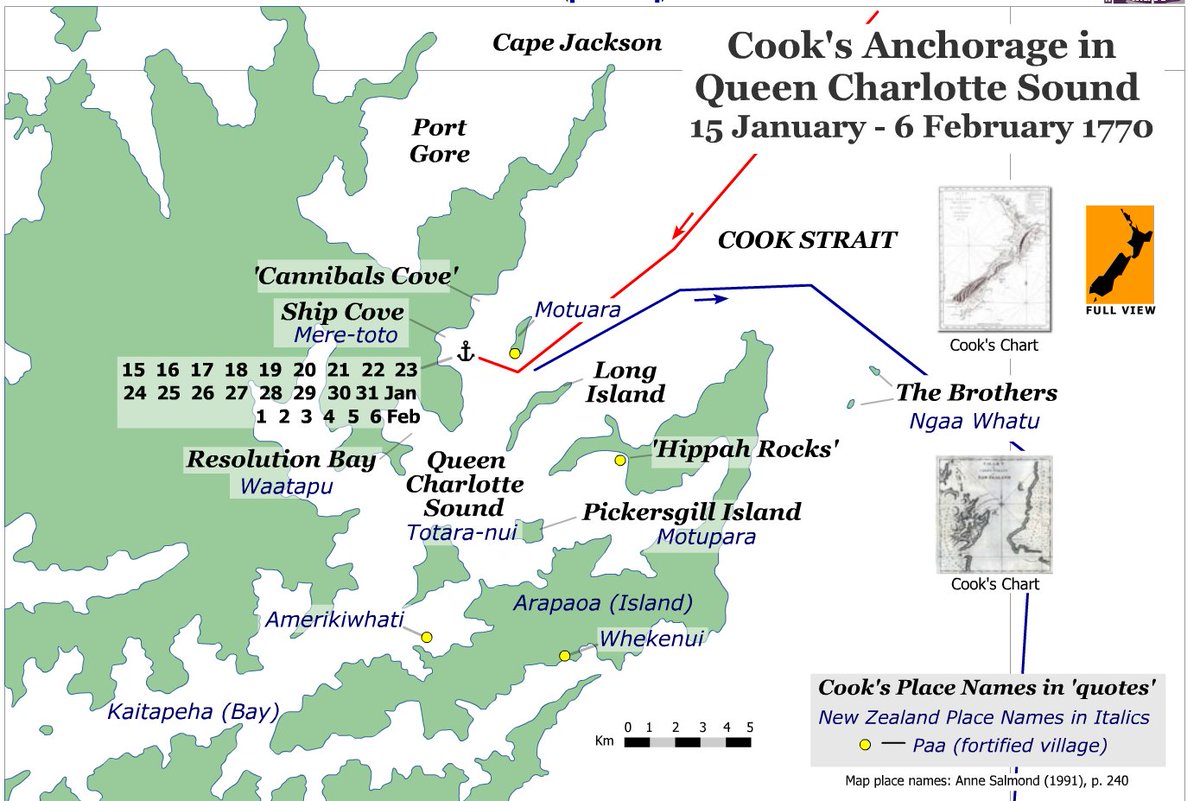
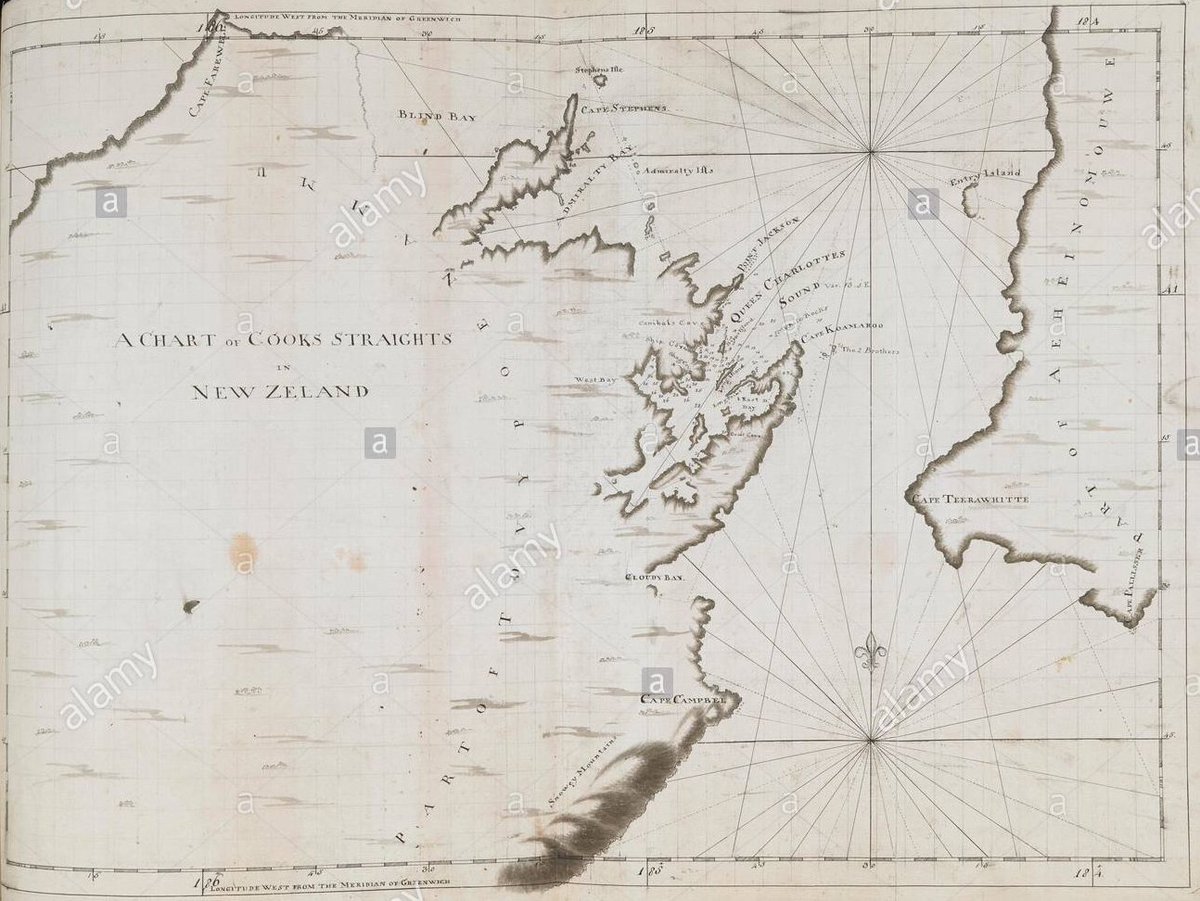
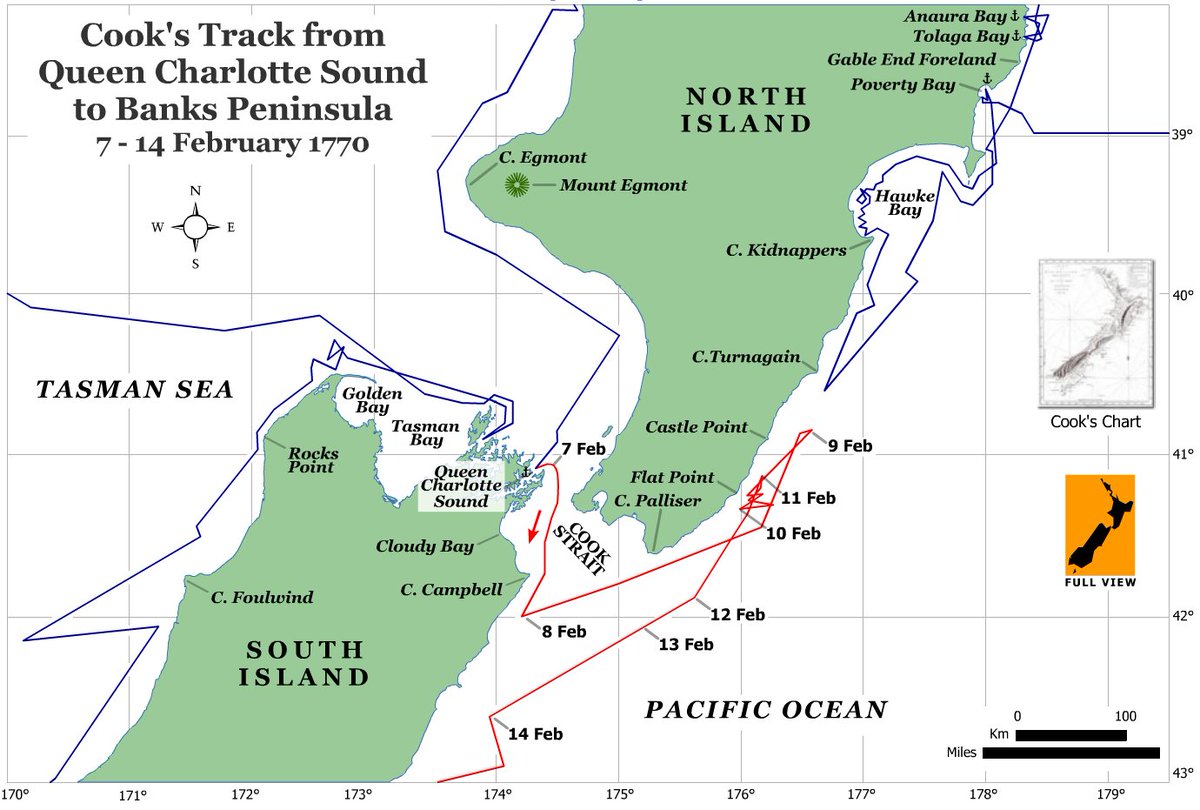
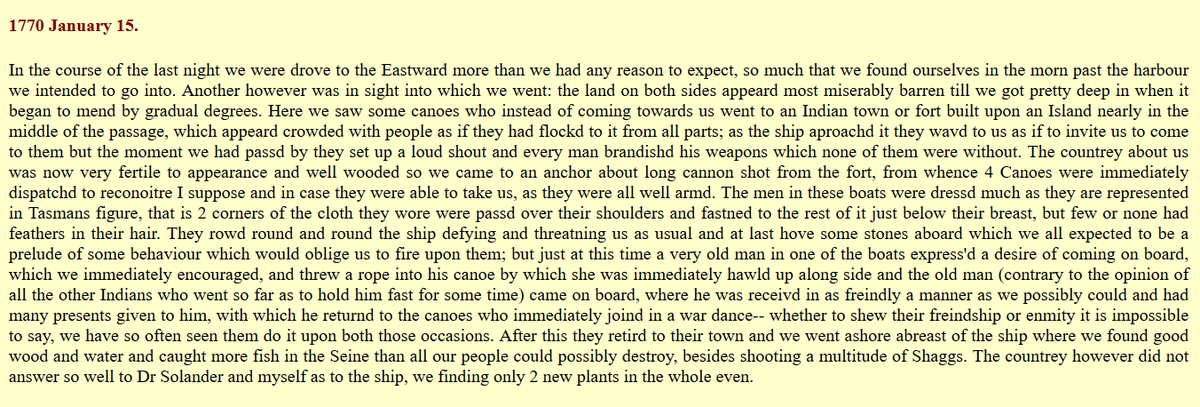
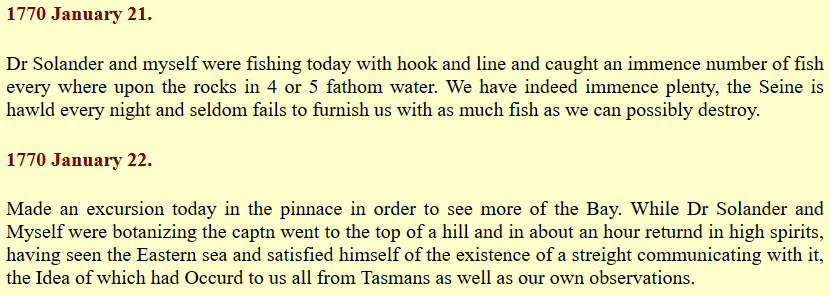
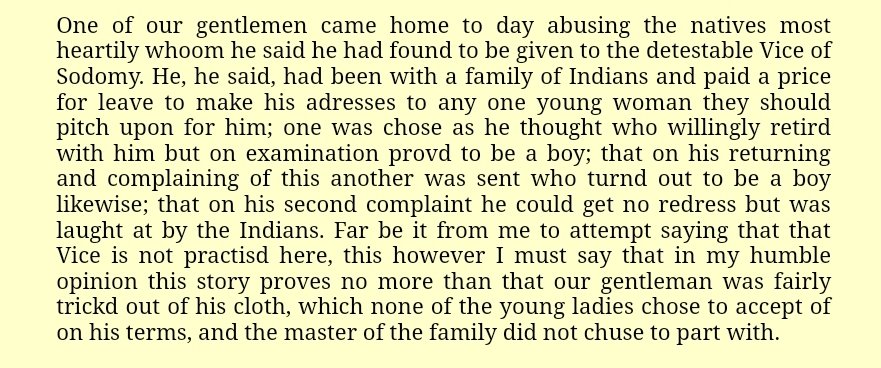
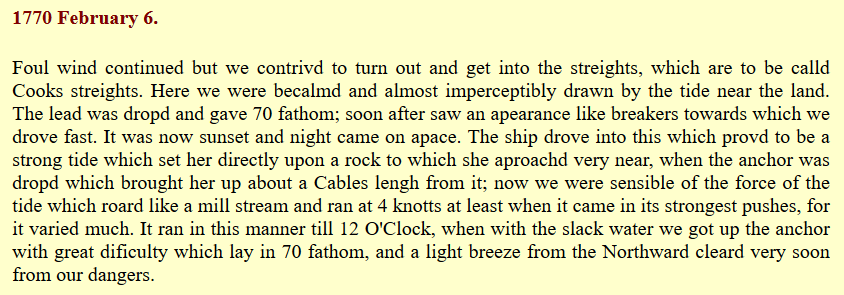
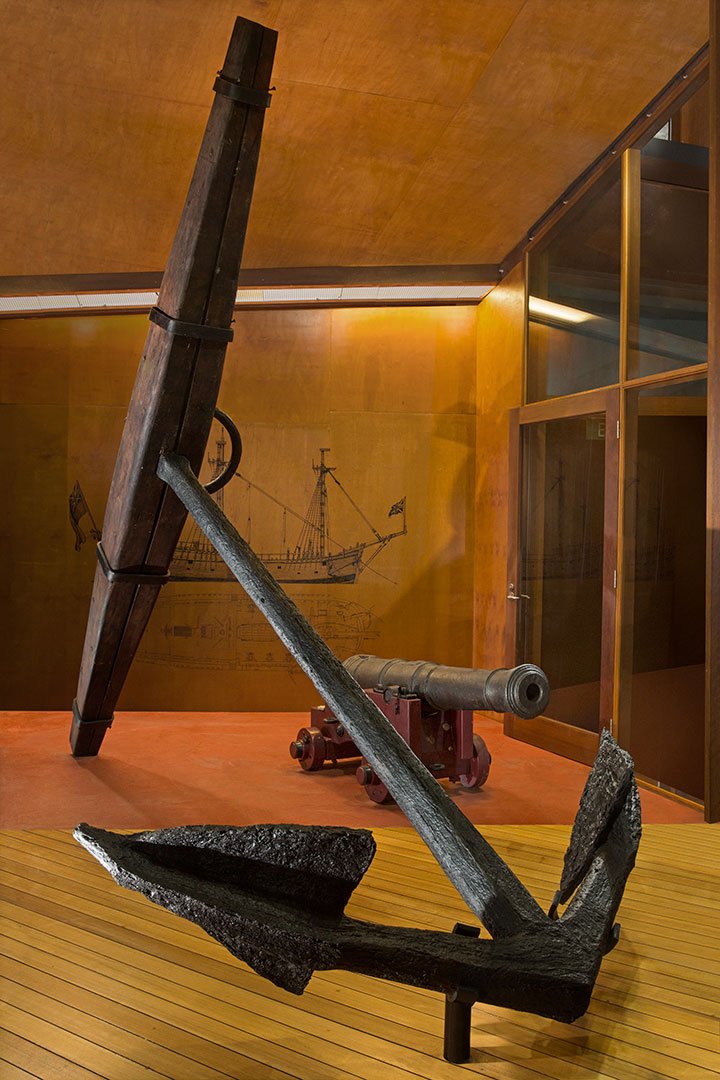
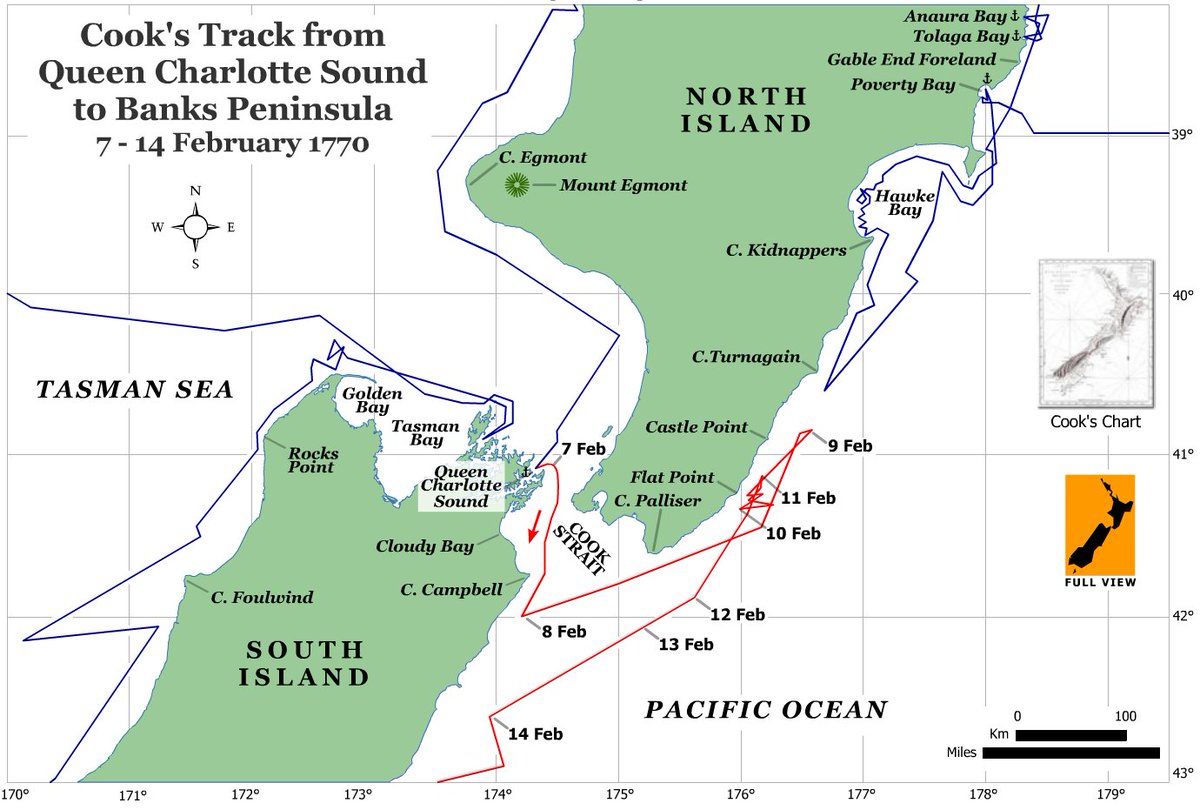
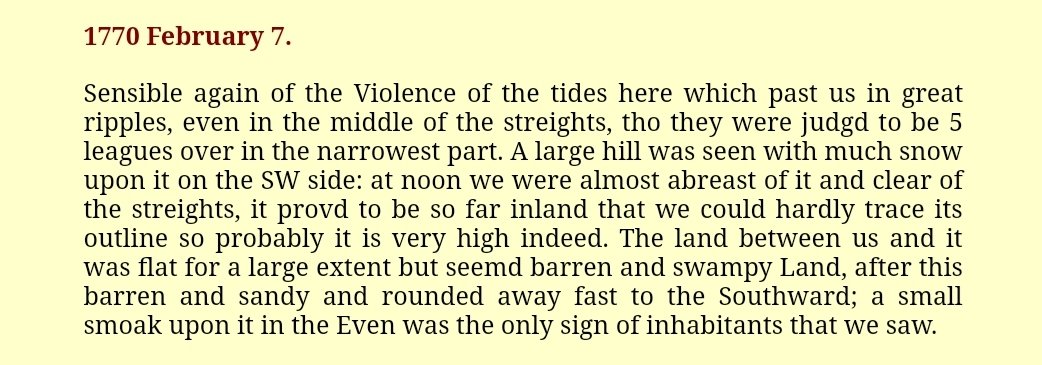


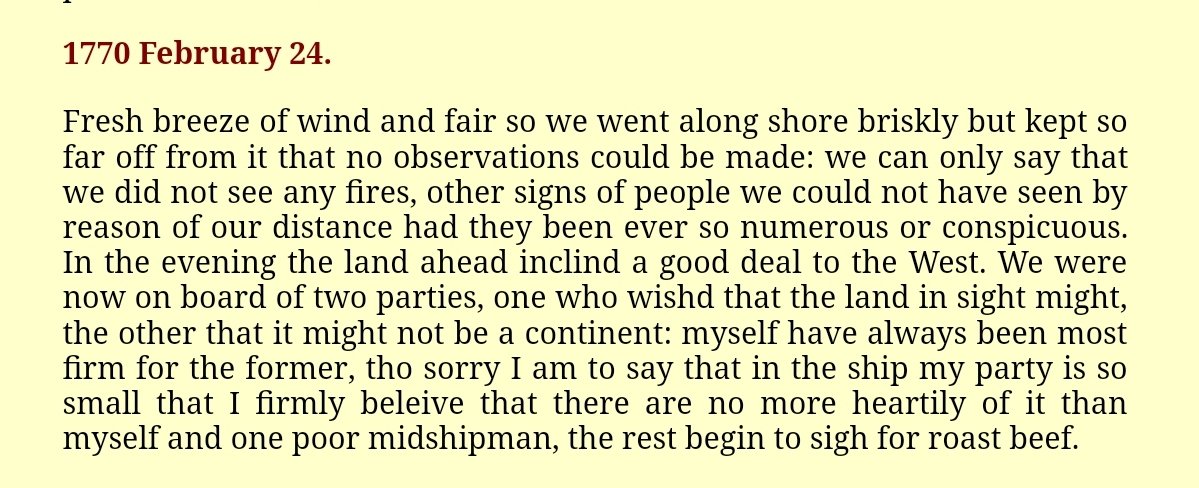
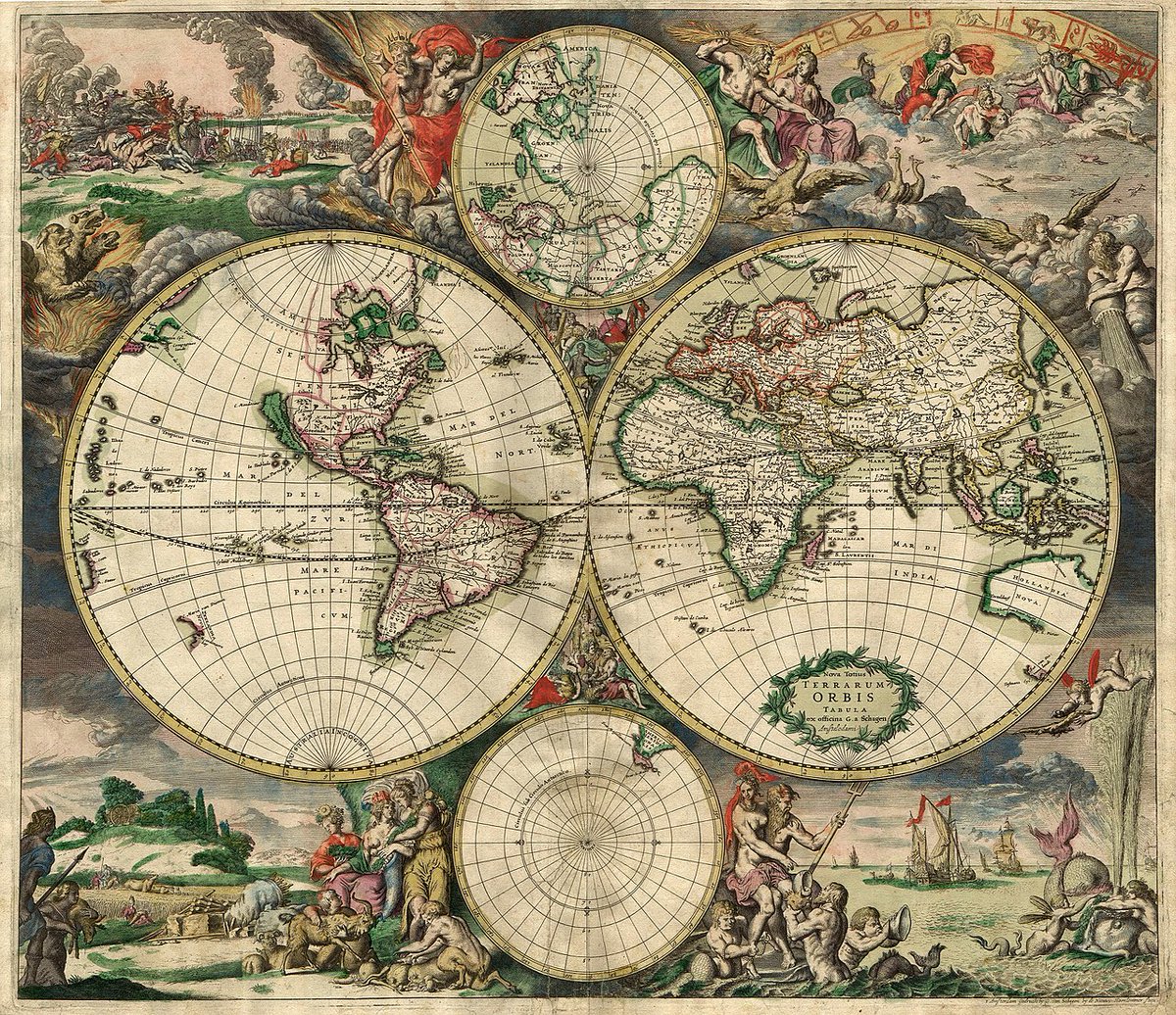
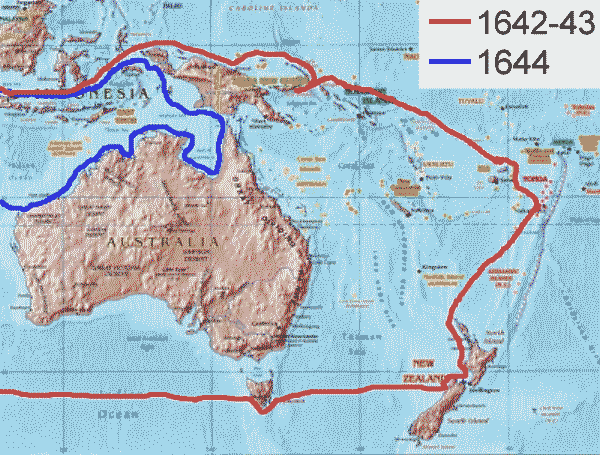

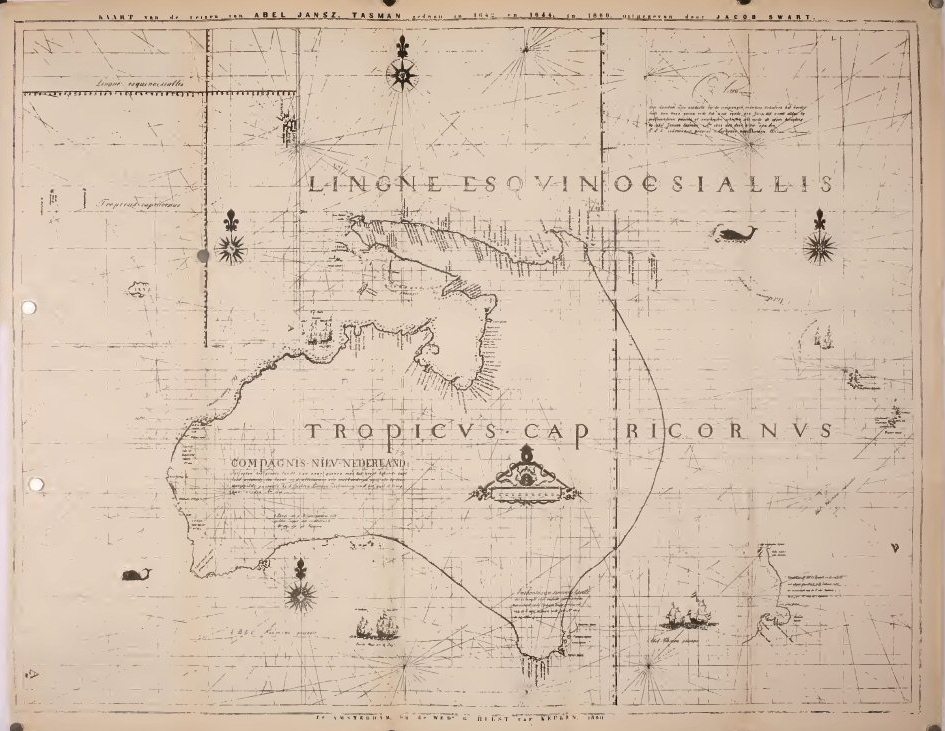
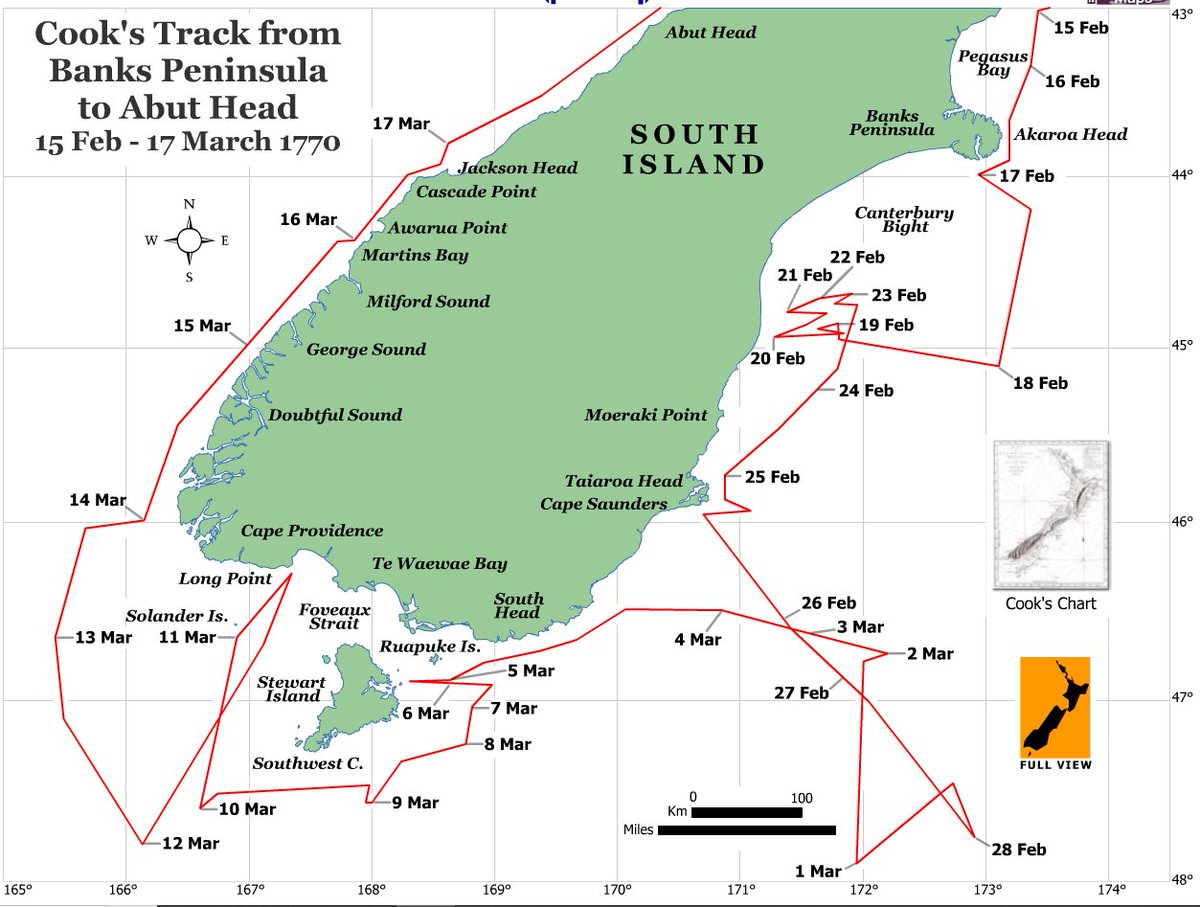
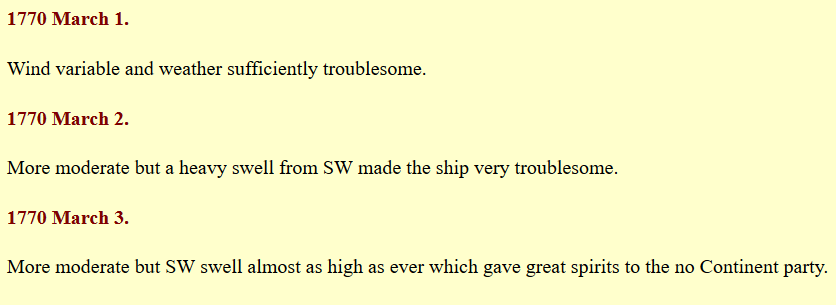
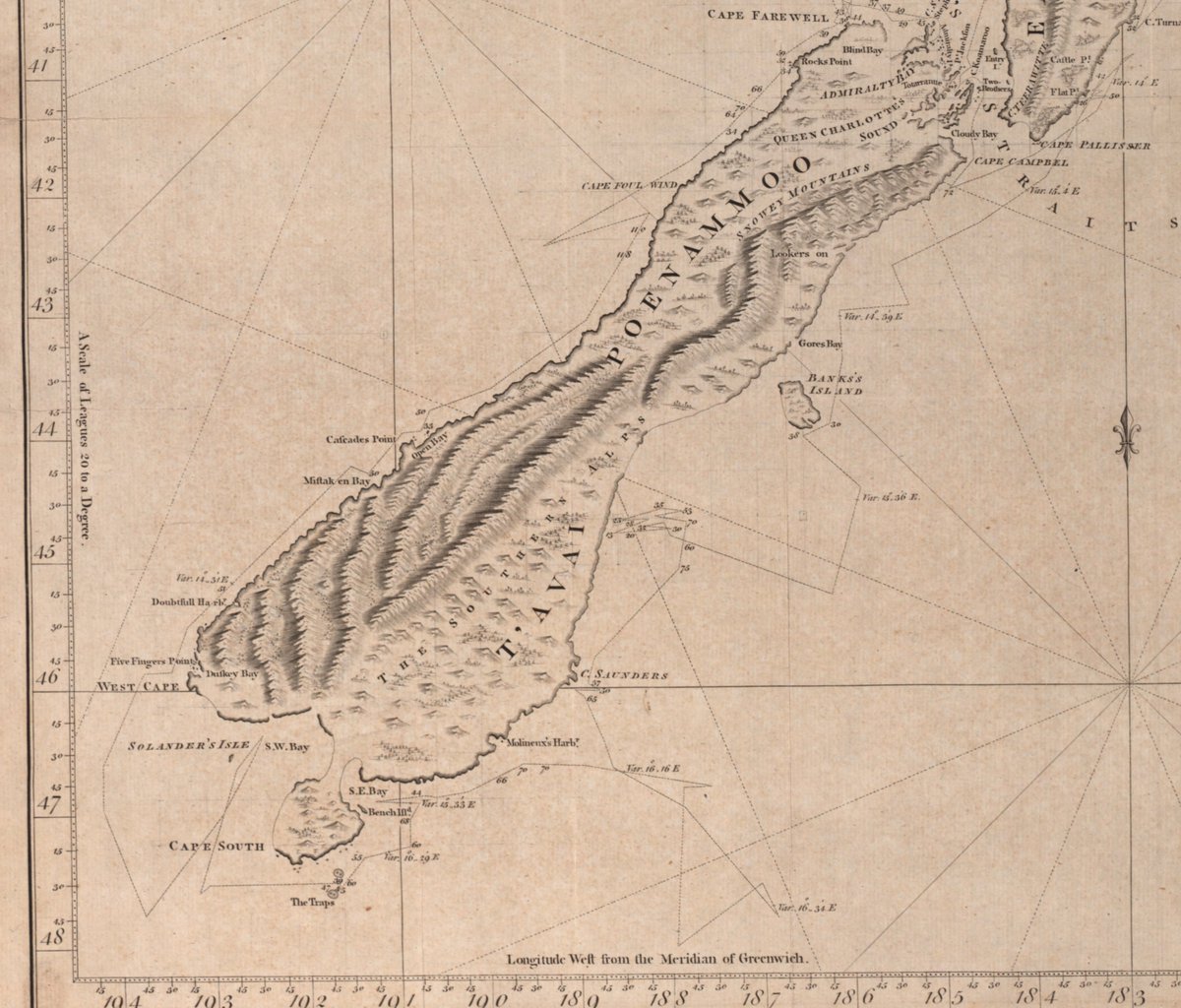 https://southseas.nla.gov.au/journals/... (big map needs Flash ... urghh).Here& #39;s Cook& #39;s chart. "Bank& #39;s Island" ... haha. https://nla.gov.au/nla.obj-2..." title="Sorry, links: https://gutenberg.net.au/ebooks05/... href=" http://southseas.nla.gov.au/journals/maps/17700317.html">https://southseas.nla.gov.au/journals/... (big map needs Flash ... urghh).Here& #39;s Cook& #39;s chart. "Bank& #39;s Island" ... haha. https://nla.gov.au/nla.obj-2..." class="img-responsive" style="max-width:100%;"/>
https://southseas.nla.gov.au/journals/... (big map needs Flash ... urghh).Here& #39;s Cook& #39;s chart. "Bank& #39;s Island" ... haha. https://nla.gov.au/nla.obj-2..." title="Sorry, links: https://gutenberg.net.au/ebooks05/... href=" http://southseas.nla.gov.au/journals/maps/17700317.html">https://southseas.nla.gov.au/journals/... (big map needs Flash ... urghh).Here& #39;s Cook& #39;s chart. "Bank& #39;s Island" ... haha. https://nla.gov.au/nla.obj-2..." class="img-responsive" style="max-width:100%;"/>
